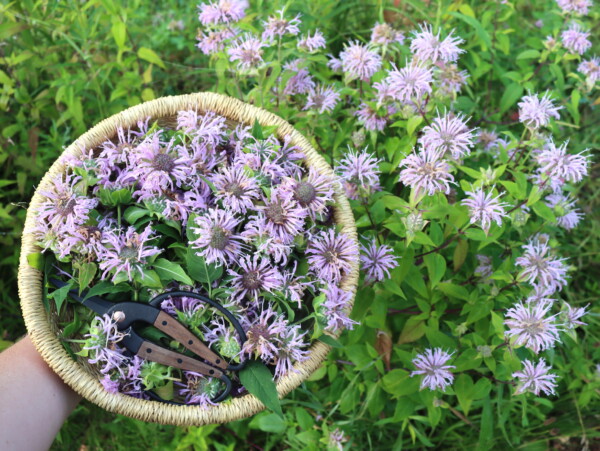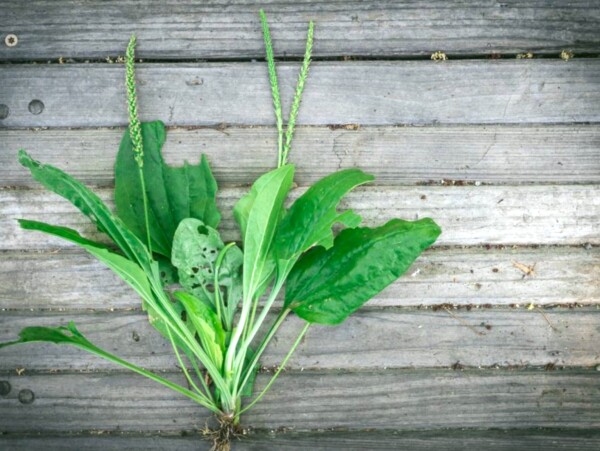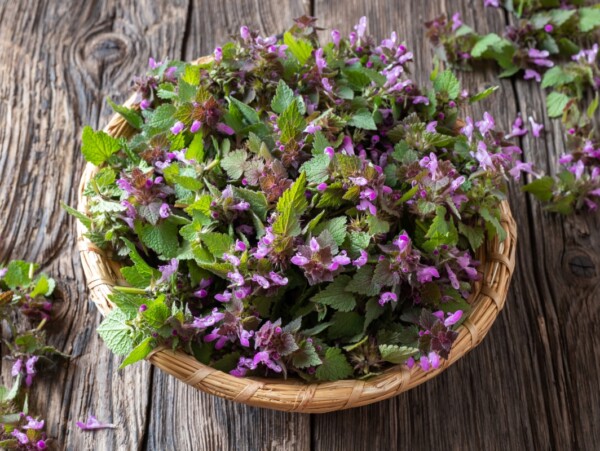Affiliate disclosure: This post may contain affiliate links. Please see our Privacy Policy.
Ranging from pale to vibrant blue, some of the weeds you find in your garden or in the wild have a stunning display!
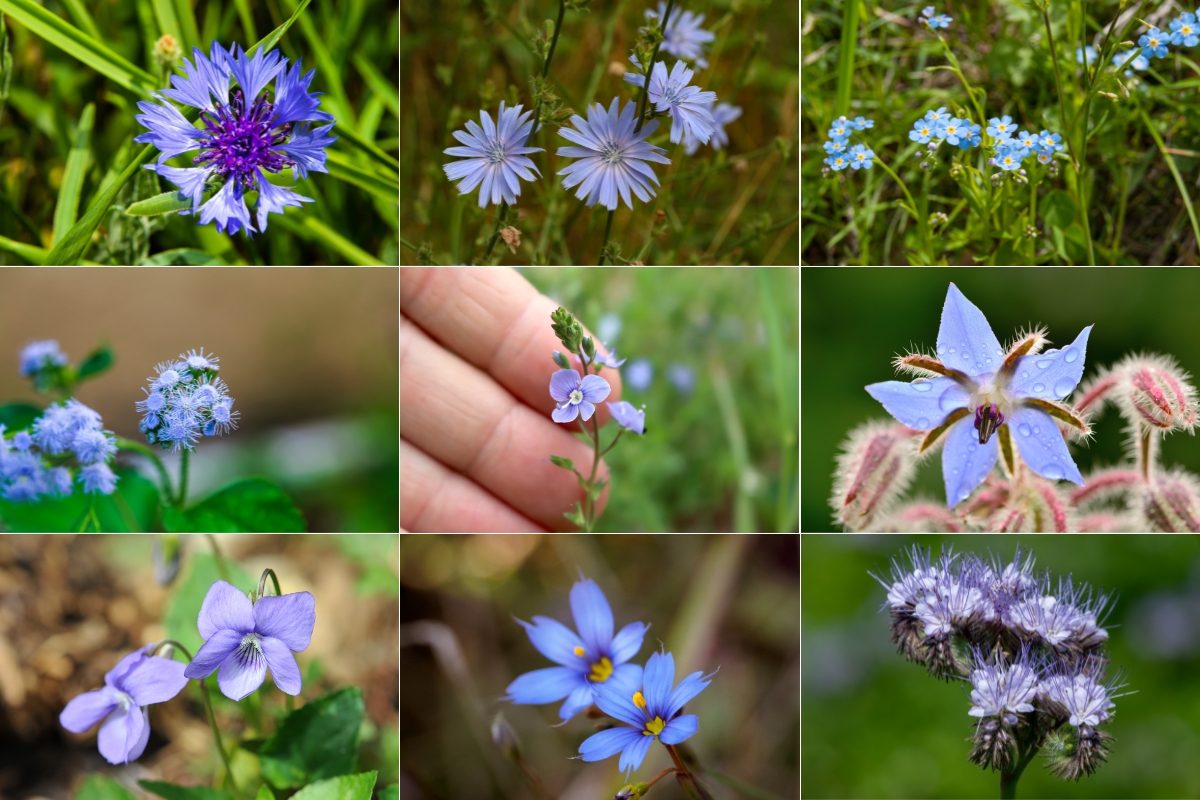
Table of Contents
- WEEDS WITH BLUE FLOWERS
- Asiatic Dayflower (Commelina communis)
- Bigleaf Lupine (Lupinus polyphyllus)
- Blue False Indigo (Baptisia australis)
- Blue Flax (Linum perenne)
- Blue Mistflower (Conoclinium coelestinum)
- Blue-eyed Grass (Sisyrinchium sp.)
- Bluehead Gilia (Gilia capitata)
- Borage (Borago officinalis)
- Chicory (Cichorium intybus)
- Columbian Monkshood (Aconitum Columbianum)
- Common Blue Violet (Viola sp.)
- Common Periwinkle (Vinca sp.)
- Common Speedwells (Veronica arvensis)
- Cornflowers (Centaurea cyanus)
- Creeping Bellflowers (Campanula rapunculoides)
- False Forget-me-not (Hackelia floribunda)
- Flossflower (Ageratum houstonianum)
- Forget-me-not (Myosotis scorpioides)
- Grape Hyacinth (Muscari armeniacum)
- Green Alkanet (Pentaglottis sempervirens)
- Hoary Aster (Dieteria canescens)
- Larkspurs (Delphinium sp.)
- Lobelia (Lobelia sp.)
- Morning Glory (Ipomoea hederacea)
- Passion Flower (Passiflora incarnata)
- Lacy Phacelia (Phacelia tanacetifolia)
- Venus’ Looking-glass (Triodanis perfoliata)
- Viper’s Bugloss (Echium vulgare)
- Virginia Spiderwort (Tradescantia virginiana)
- Virginia Waterleaf (Hydrophyllum sp.)
- Wild Clary (Salvia verbenaca)
- Woodland Lettuce (Lactuca floridana)
- More plants with Blue flowers:
- Wildflowers with Blue Flowers
- Rare to Endangered Blue Wildflower Species
This article is written by Morgan Hyde, a reference librarian from Arizona. Her work for the library has refined her passion for learning and deep research—a passion that began in her rural AZ upbringing. If it’s something she can do on her own, it’s something she wants to know about!
By nature of the name “weed” you’ll find that most of the plants on this list are very common—they grow aggressively and can be hard to remove. But you’ll also find that many of them have been used for centuries, if not millennia, as food or medicine. The years may have seen them fall out of favor, but those uses still remain.
Blue flowers are an excellent draw for pollinators and it’s no surprise you’ll find these weeds are almost universally good for native bee, butterfly, and hummingbird populations. Be aware, though, that just because the bees love it, doesn’t mean they’re good for human consumption.
Quite a few weeds with blue flowers are edible and useful, but some are toxic. Keep a special eye out for these highly toxic to poisonous plants: Blue False Indigo, Columbian Monkshood, False Forget-me-nots, Larkspurs, and Lobelias.
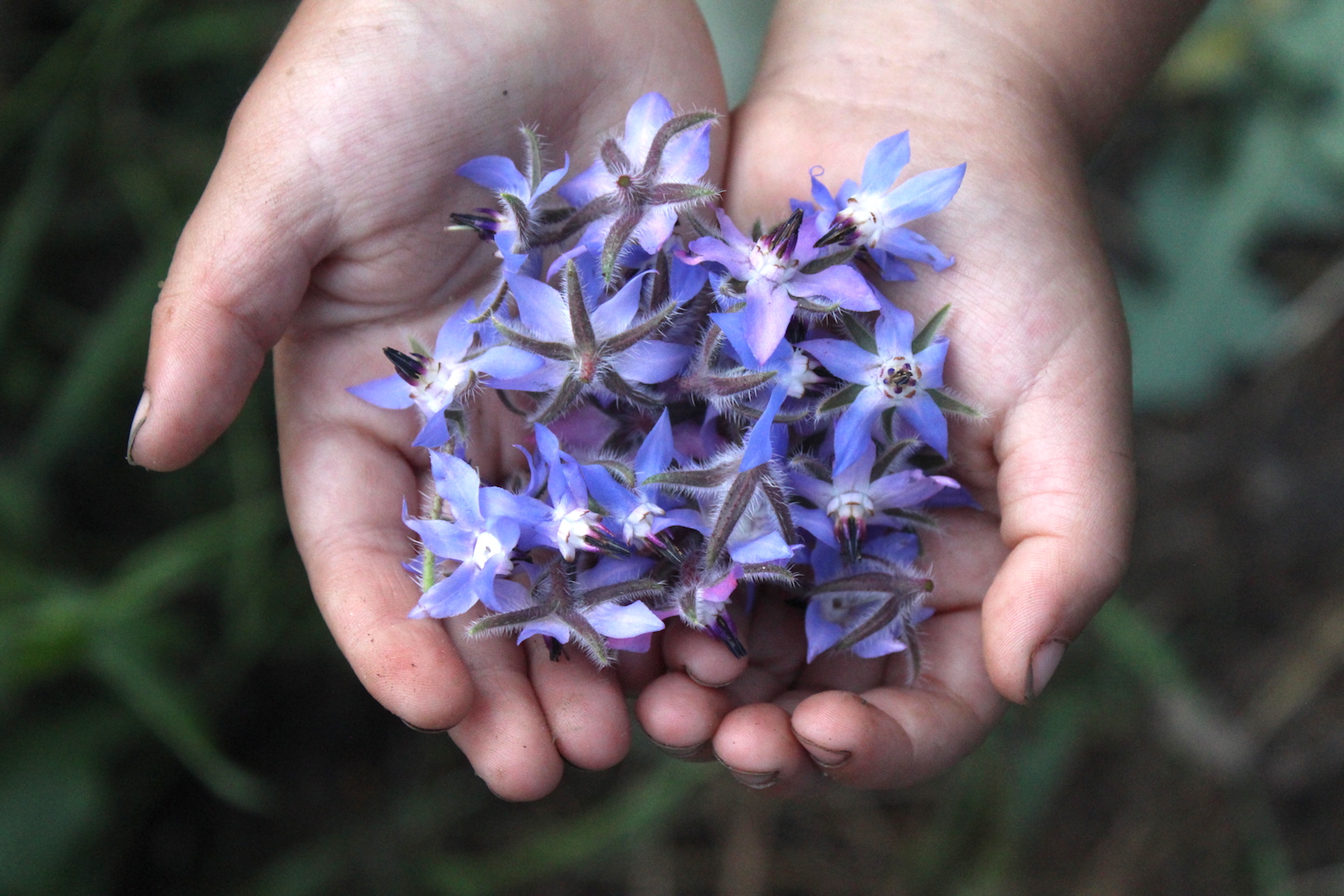
WEEDS WITH BLUE FLOWERS
Down by your feet or high up in the air, you’ll find blue flowers nodding out at you almost everywhere you look in the spring. Many prefer shady, moist areas—though a few are only happy when they’re in full sun.
Several plants on this list are non-native species that were brought to the US and have since escaped into the wild. The majority, though, are native and considered weeds because they’ve become invasive (sometimes crossing from one coast to the other), or are highly toxic. Whatever the reason you’ll find them described as a weed, just remember that no plants on this list are completely useless. Check out some of the ways you can enjoy these wild plants below!
Asiatic Dayflower (Commelina communis)
Starting off with one of the more unique flower shapes in this list, the Asiatic Dayflower is a delicate, 3 petaled splash of blue you’ll find in shady areas. Considered invasive both in the US and in its native soil, you can cultivate it in your garden only if you’re prepared to keep it in check.
Fortunately, while definitely weedy, Asiatic Dayflowers are highly useful! The flowers, leaves, and shoots are edible raw or as a potherb. Additionally, it has traditionally been used as a dye, producing a beautiful blue ink. Items dyed with Dayflowers do have a tendency to fade to a muddy green when exposed to sunlight, so be careful what you choose to dip into its ink!
Key identification features
Spiderwort and Dayflowers can be confused because of their similar flower shape. The easiest way to tell the difference is to look at the stems: Asiatic Dayflowers have stems growing in a zig-zag pattern while Spiderwort has straighter stems almost completely covered in leaves.
Flowers:
- 2 large blue petals on top
- 1 small white petal on bottom
- At the end of long stalks
Leaves:
- Lance-shaped
- 2-4in long
- Parallel veins
General:
- Stems grow in a zig-zag pattern
Here’s how to identify Dayflowers (Commelina sp.)
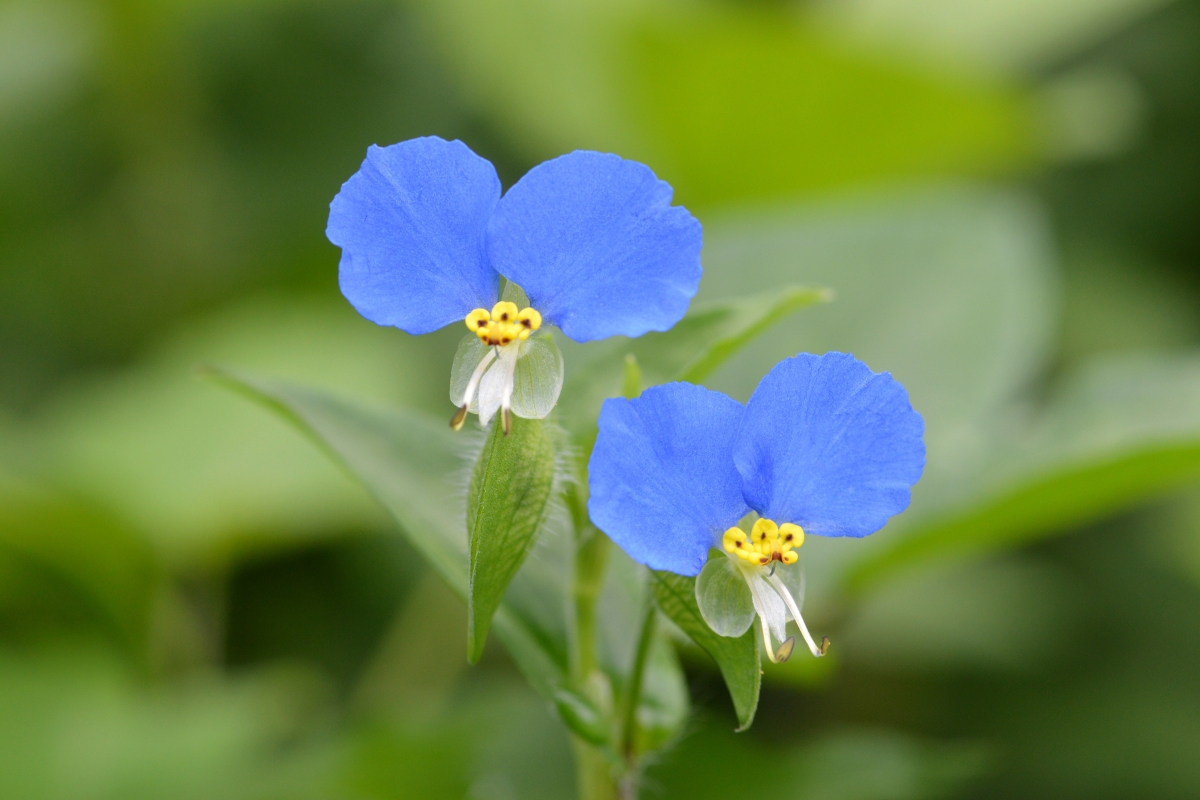
Bigleaf Lupine (Lupinus polyphyllus)
A beautiful treat to see out on walks or part of any garden ensemble, Bigleaf Lupine is a showy plant with dozens of tiny blue flowers. Bees and Hummingbirds adore it and will happily come to collect nectar from mid-spring to mid-summer.
Native to the western US, Bigleaf Lupine has become a problematic invasive on the eastern side of the country. It’s begun pushing out native plants and has cross pollinated with other varieties of lupine critical to certain insects’ survival. The roots of Lupines are edible both when raw and cooked—so feel free to dig them up for lunch!
Key identification features
Flowers:
- Pea-like
- .5in individual flowers
- 15in long clusters
Seeds:
- Hairy seed pod
- Mottled purple when ripe
- 3-10 seeds per pod
Leaves:
- Compound with 9-14 leaflets
- Narrow, pointed
- Palmate
Here’s how to identify Bigleaf Lupine (Lupinus polyphyllus)
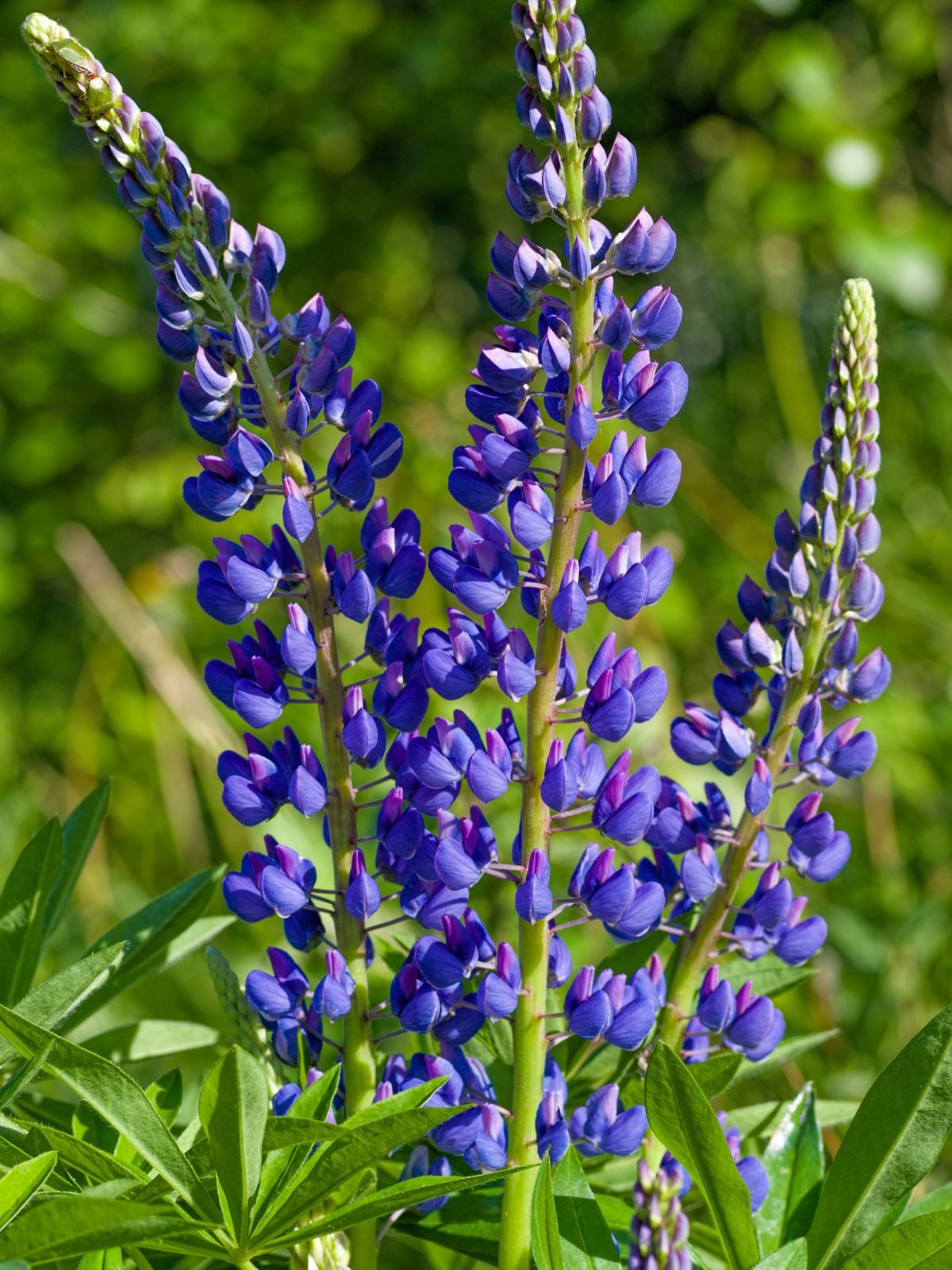
Blue False Indigo (Baptisia australis)
Taking a walk in a prairie and suddenly hearing a telltale rattle might not necessarily mean you’ve stumbled upon an irate snake. Also known as Rattleweed, Blue False Indigo’s seed pods sound extremely similar to a rattlesnake when they dry at the end of the season.
Before true indigo became readily available in the Americas, Blue False Indigo was heavily used as a substitute to dye fabrics a deep blue. As a toxic plant, it was used in root teas as an emetic but was rarely eaten. On occasion, Native Americans would hold the roots in their mouths as a treatment for toothaches though it’s unclear how effective this might be today.
Key identification features
Flowers:
- Grow on long upright spikes
- Deep blue
- Pea flower shaped
Seeds:
- Oblong pods
- Brown, kidney shaped
- Dry pods sound like rattlesnakes
Leaves:
- Clusters of 3 leaflets
- Soft green
- Ovate shaped
General:
- 3-4ft tall and wide
- Bushy clumps
Here’s how to identify Blue False Indigo (Baptisia australis)

Blue Flax (Linum perenne)
Originally introduced to the US from Eurasia, Blue Flax isn’t considered a weedy or invasive plant. It has escaped cultivation and can be found commonly growing wild in the western US.
A highly useful plant, Blue Flax is often grown deliberately for its fibers and seed oils. Wildlife enjoy browsing the foliage while birds will eat the seeds each year. In damaged areas, Blue Flax can be introduced to help prevent soil erosion.
Key identification features
Flowers:
- 5 petals
- Grown in clusters
- Blooms for 8-12 weeks
Seeds:
- Small
- Brown
- Ovate
Leaves:
- Simple
- Blue-green
- Narrow, growing in tufts
General:
- Woody at the base
- Semi-evergreen but short-lived
- Stems are thin but tough
Here’s how to identify Wild Blue Flax (Linum sp.)
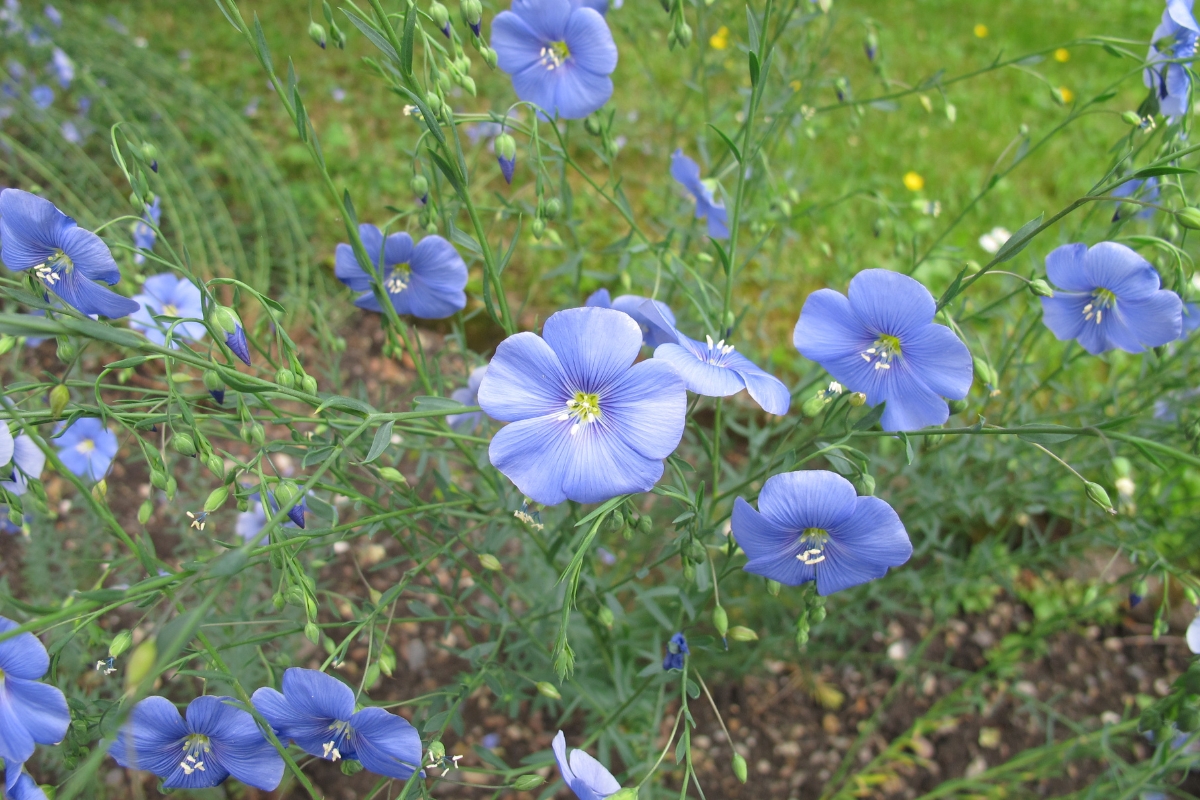
Blue Mistflower (Conoclinium coelestinum)
Description flowers late summer until frost, 2ft tall, dense ground cover, aggressive grower. You can spot Blue Mistflower easily by looking out for its bright blue, shaggy pom-pom flowers.
These will grow low to the ground in dense clusters—Blue Mistflower is an aggressive plant and forms groundcover quickly. An attractive plant, it’s not ideal for small gardens as it will push other plants out.
Historically, Blue Mistflower was used to treat coughs and colds though little information remains to say how. Today it’s mostly used as an excellent pollinator attraction for a variety of bees, moths, and hummingbirds. As the flowers last late into the season, it makes for a welcome pollinator snack before full winter sets in!
Key identification features
Blue Mistflower has a similar flower shape to Flossflower. Both look like shaggy pom-poms, but Flossflowers tend to look a bit more dense and full. Additionally, the leaves of Flossflower are more heart shaped by comparison. See below for a deeper description of Flossflowers.
Flowers:
- Tubular disc flowers
- No ray flowers
- Fluffy
- 1/4 in long
Leaves:
- Opposite
- Triangular
- Bluntly toothed
Here’s how to identify Blue Mistflower (Conoclinium coelestinum)
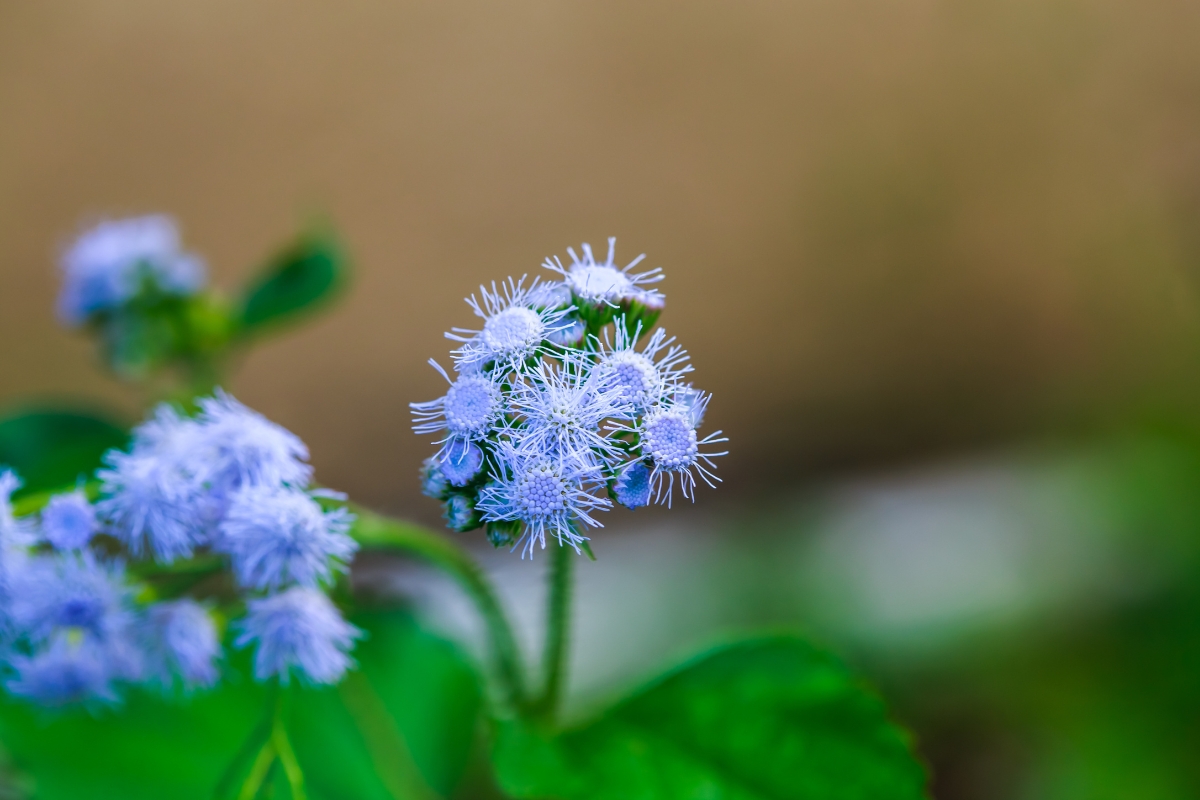
Blue-eyed Grass (Sisyrinchium sp.)
Perhaps one of the most unfairly categorized weeds, Blue-eyed Grass gets this designation primarily when it begins growing on otherwise smooth lawns. Out in its native landscape it makes up an essential part of natural prairies and meadows.
Today, Blue-eyed Grasses are often used as an ornamental plant in many natural gardens for their pleasing foliage. In the past the leaves of this plant were cooked and eaten as a method for regulating the stomach as either a laxative or to treat diarrhea.
Key identification features
Flowers:
- Star-shaped
- Yellow center
- 3 sepals and 3 petals
Seeds:
- Tiny and black
- Small, round seed capsules
Leaves:
- Form fan-shaped rosettes
- Upright
- Sword-shaped
Here’s how to identify Blue-eyed Grass (Sisyrinchium sp.)
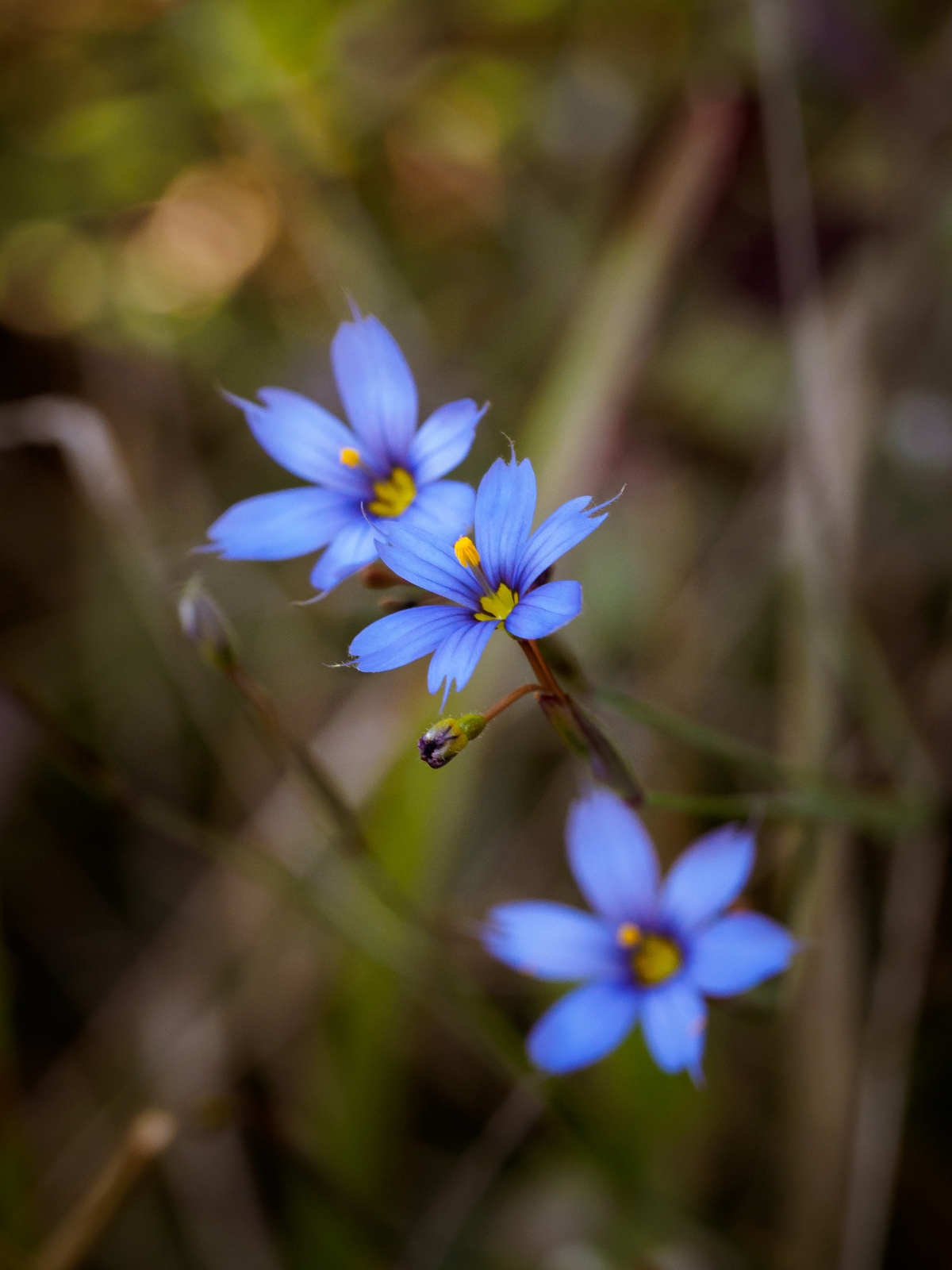
Bluehead Gilia (Gilia capitata)
Bluehead Gilia has been identified as having special value to native bees and in general is a beautiful pollinator attraction. It is highly drought tolerant and is a wonderful self-seeder. Because of how readily it spreads, in low competition areas like the western US, Bluehead Gilia has come to be seen as mildly invasive.
It’s neither considered toxic nor considered edible and should be approached as if it were mildly toxic to ingest. You’ll most easily spot Bluehead Gilia in the spring when the upright flowers are in bloom. During the heat of summer the whole plant will begin to die back to prepare to seed for the following spring.
Key identification features
Flowers:
- Globe-shaped
- 1-2in across
- 50-100 tiny flowers per globe
- Blue, white, or pink stamens
Leaves:
- Small
- Bluish-green
- Fern-like
General:
- Sticky, thick fur on stems and leaves
Here’s how to identify Bluehead Gilia (Gilia capitata)
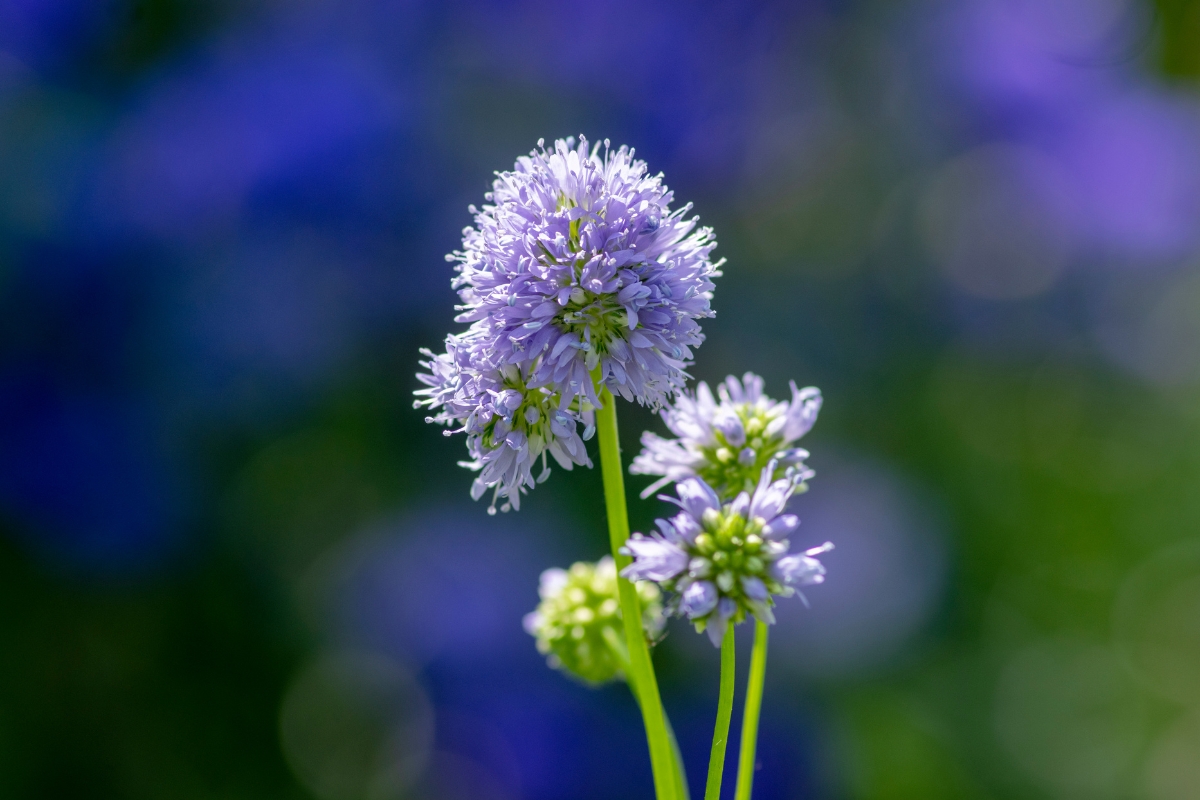
Borage (Borago officinalis)
Well-known as a salad additive in Europe, the leaves and flowers of Borage are edible. While the leaves lend a salty cucumber flavor to meals, the flowers are sweet and almost honey-flavored. The oil from the seeds is commercially harvested to make nutritional supplements. Closer to home, you’ll find Borage makes an excellent companion plant for strawberries, spinach, and squash.
Recent studies have shown that eating Borage as a major part of your diet may cause liver damage, so eat it sparingly. Additionally, as a non-native plant to the US, it has escaped gardens and become invasive in much of the US. If you see it growing in sunny areas, feel free to pull it up and bring it home!
Key identification features
Borage and Lungwort look rather similar but are fairly easy to tell apart. Where Borage has star-shaped flowers that are blue throughout their cycle, Lungwort’s flowers change colors as they age and are shaped like a bell.
Flowers:
- Star-shaped
- Grown in clusters
Seeds:
- 4 per flower
- Black when ripe
- Oval shaped
Leaves:
- Wrinkled
- Dull gray-green
- Covered in bristly hairs
General:
- One long taproot
Here’s how to identify Borage (Borago officinalis)
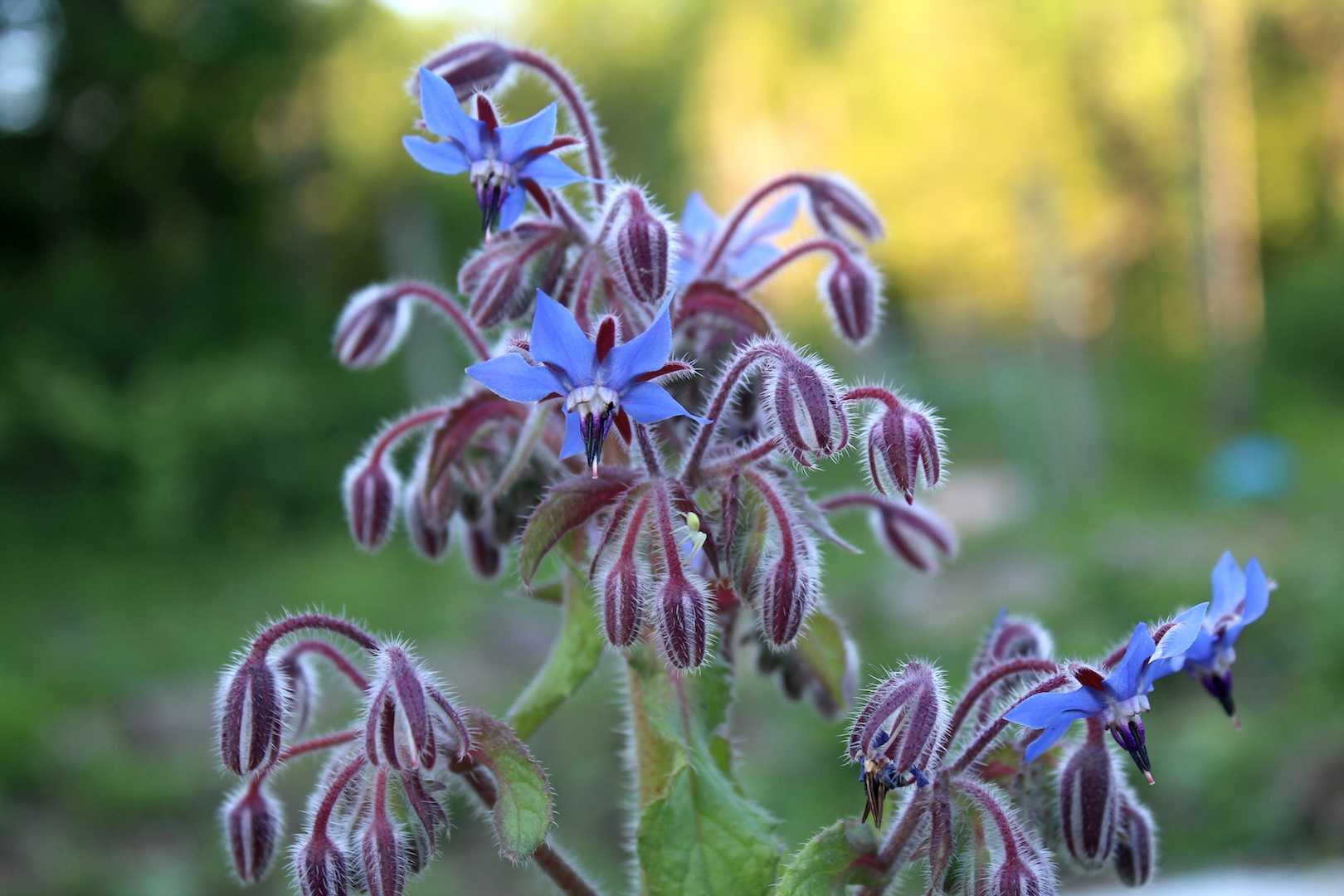
Chicory (Cichorium intybus)
Chicory has a long history of uses, some of the earliest documented in Egypt showing its use as a medicine, vegetable, animal feed, and a coffee substitute. Today, Chicory is grown and processed on an industrial scale for a number of uses including managing diabetes.
A pretty plant, you’ll most often notice Chicory growing along roadsides. It doesn’t make a good ornamental plant as the flowers only appear in its second year of life and is an invasive plant. But if you find it in your garden, you can harvest the young bitter leaves for salads or the older leaves to add into a soup!
Key identification features
Chicory is often called Bachelor’s Button even though that name is more commonly associated with Cornflowers. For a comparison of the plants, see below.
- Flowers:
- Strap-shaped petals
- Numerous petals
- 5 teeth in the petal ends
- A single flower lasts for one day
Seeds:
- Mottled
- Oblong
- Fringe of bristles at one end
Leaves:
- Lanceolate
- 3-10in long
- Irregularly toothed or deeply lobed
General:
- Rigid, hairy stems
- Milky sap
Here’s how to identify Chicory (Cichorium intybus)
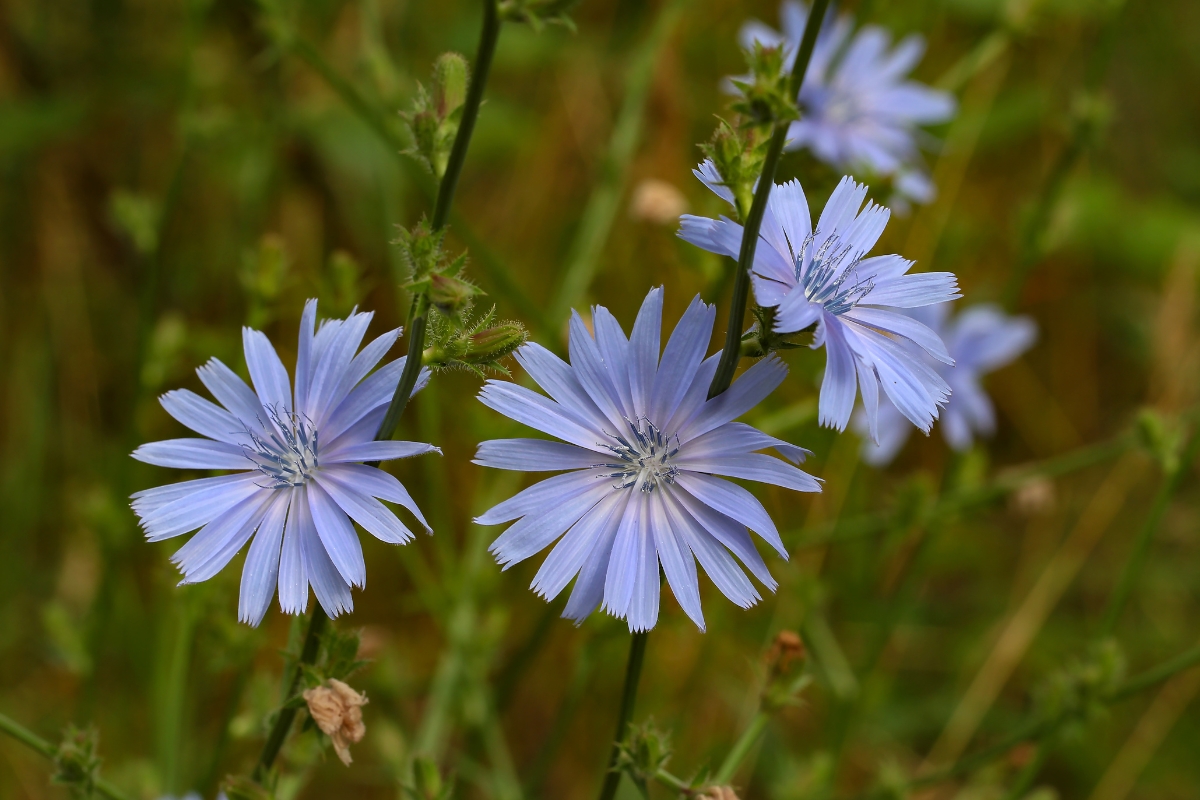
Columbian Monkshood (Aconitum Columbianum)
One of the most poisonous plants on this list, every part of the Columbian Monkshood is considered dangerous to eat. While certain nerve and heart sedatives can be processed from the root, this is not something that should be attempted at home.
You’ll mostly find it growing in shady, moist areas with tall stems reaching anywhere from 6-10ft in height. While generally an erect plant, it can be found trailing along the ground. It’s not considered invasive, but if you have children or curious pets you’ll want to remove it speedily from your garden.
Key identification features
You may confuse the leaves of the Tall Larkspur (Delphinium barbeyi) for the leaves of Columbian Monkshood especially as they grow in the same area. Fortunately, you can tell the difference by checking for the hollow stems characteristic of Larkspurs. For a deeper description of Larkspurs, see below.
Flowers:
- 5 total petals
- 1 upper petal acts as a hood
- 2 petals tucked under the hood
Leaves:
- 5-7 toothed lobes
General:
- Stems are hollow
Here’s how to identify Columbian Monkshood (Aconitum Columbianum)
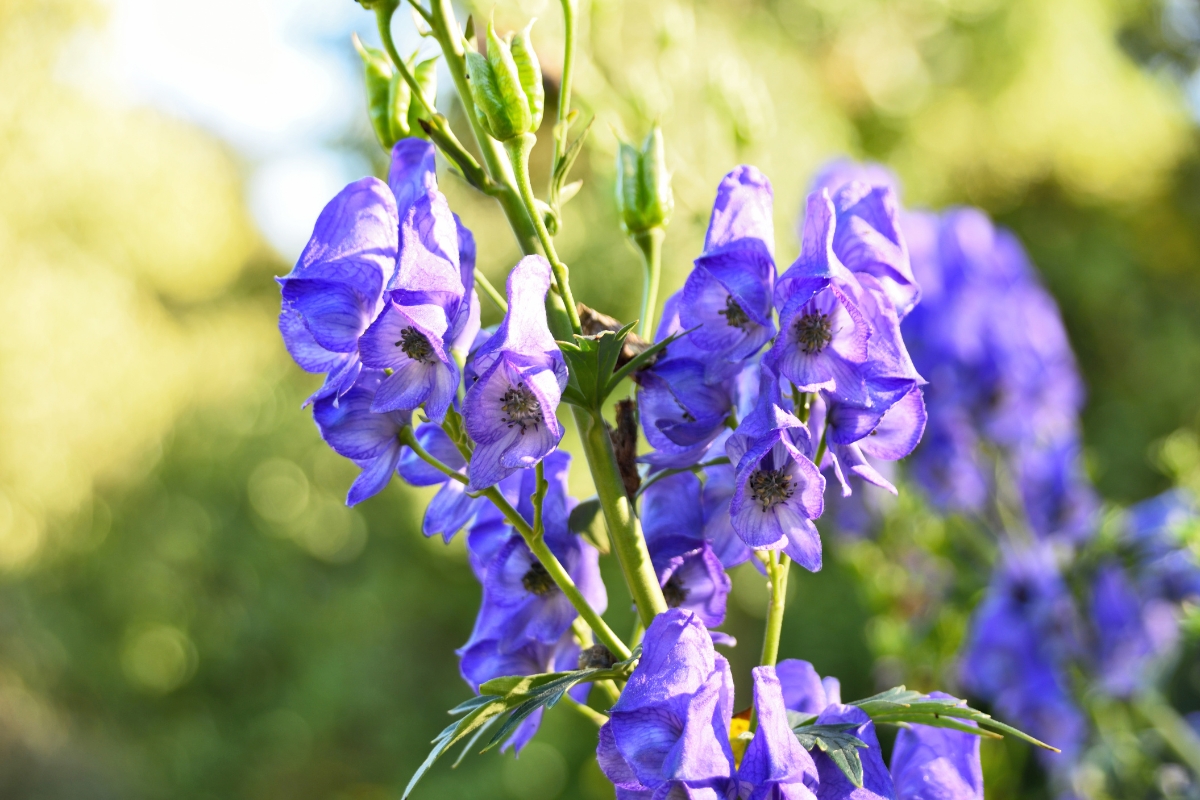
Common Blue Violet (Viola sp.)
Common Blue Violets are often maligned by those maintaining lawns due to how tenaciously they cling to moist soil. Once they’ve settled into an environment they like it can be almost impossible to get rid of them.
Outside of lawns, Common Blue Violets are a treat to find in and around gardens or out in the wild! Both the leaves and the flowers are edible (though the flowers are the tastier of the two). A variety of dishes can be made with flowers from tea to jellies to syrups. The raw leaves are a bit chewy and are better suited to being made into salves, soaps, or cough syrups for soothing almost any kind of irritation you might run into.
Key identification features
Flowers:
- 5 petals
- Rounded star shape
- Top point of the star is downward
Leaves:
- None on flower stalks
- Smooth
- Heart-shaped
- Edges curl in to the center
Here’s how to identify Common Blue Violet (Viola sp.)
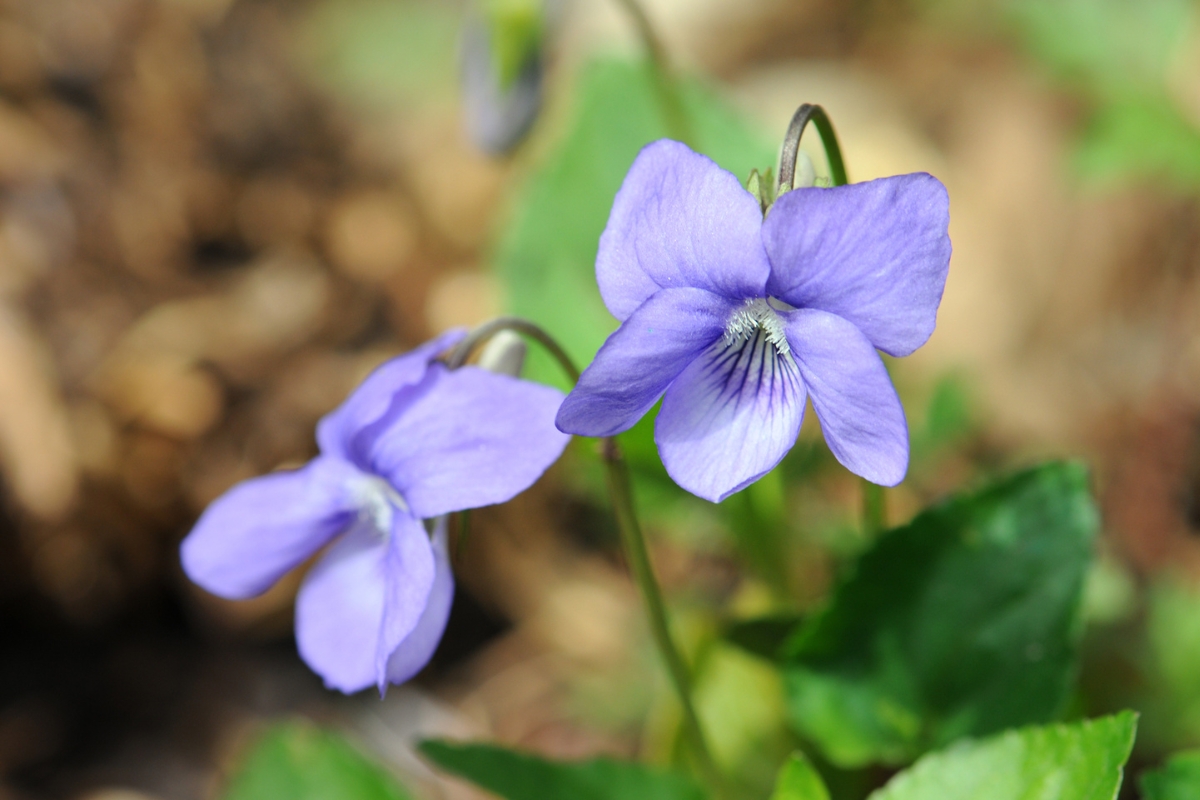
Common Periwinkle (Vinca sp.)
Even when the flower is sitting still, the petals of the Common Periwinkle look like they’ve been spinning around like a windmill. Framed by dark glossy leaves, the flowers look like they’ve been scattered across a smooth carpet. Common Periwinkle is an aggressive grower and is considered invasive in the US, forming dense mats of roots and leaves that push out native plants.
In folk medicine Periwinkles have been used to treat everything from heart problems to menstruation symptoms. Recent studies have found that it increases oxygen use in the body and helps move blood to the brain, making it a supplement used to help ease the symptoms of vertigo, Alzheimer’s, and headaches. It’s generally advised to check with a physician before using Periwinkle to treat any condition.
Key identification features
Flowers:
- 5 petals
- Flat, windmill shape
- Solitary
Leaves:
- Dark green
- Glossy
- Elliptical
- Light green veins
General:
- Hollow stems
Here’s how to identify Common Periwinkle (Vinca sp.)
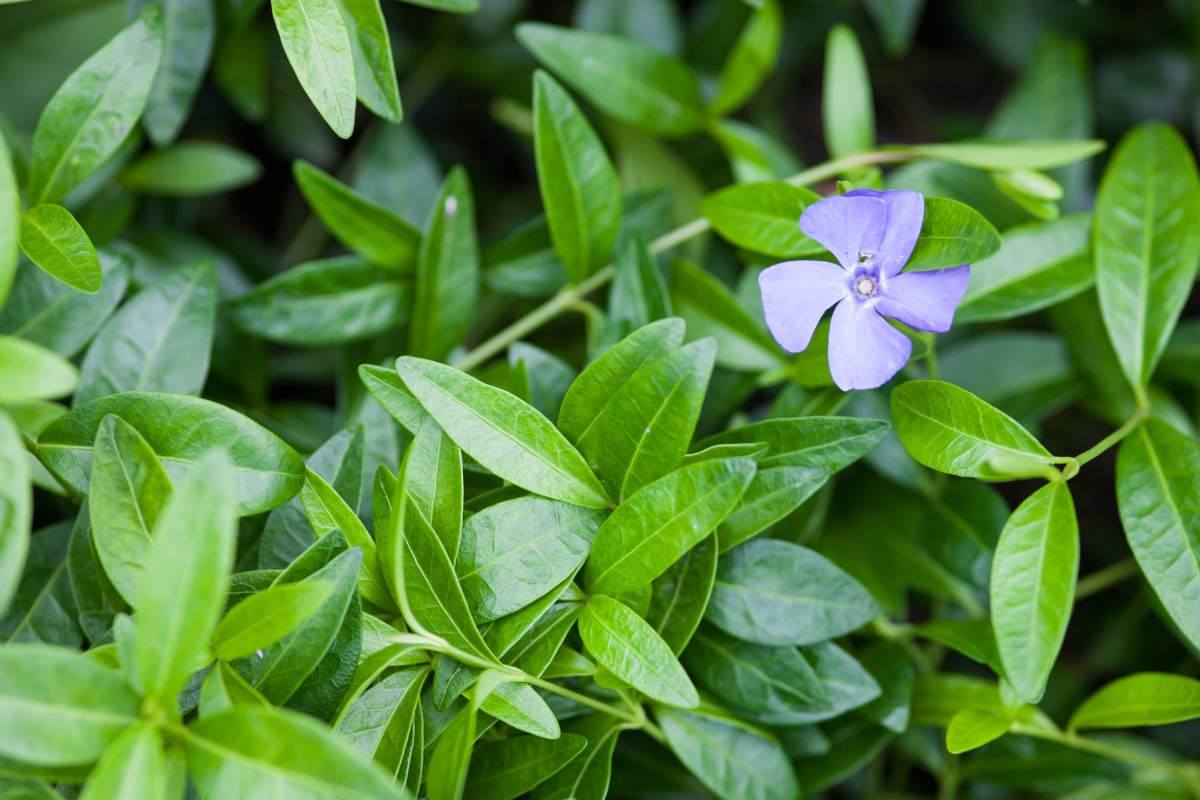
Common Speedwells (Veronica arvensis)
There are a large number of Speedwell varieties that grow in the US and many look highly similar to one another. Of all the varieties, however, the Common Speedwell is a non-native that has become the most invasive of the group.
Like all Speedwells, the common variety has a variety of uses. Its leaves and flowers are edible (though you might not enjoy them). And it has medicinal benefits when made into teas, salves, or tinctures.
Key identification features
Flowers:
- 4-5 blue petals
- 4 hairy green sepals
Leaves:
- Ovate
- 2in long
- Minutely toothed
- Yellow-green
- Hairy
General:
- Hairy stems
- Brown to green stems
Here’s how to identify Speedwells (Veronica sp.)
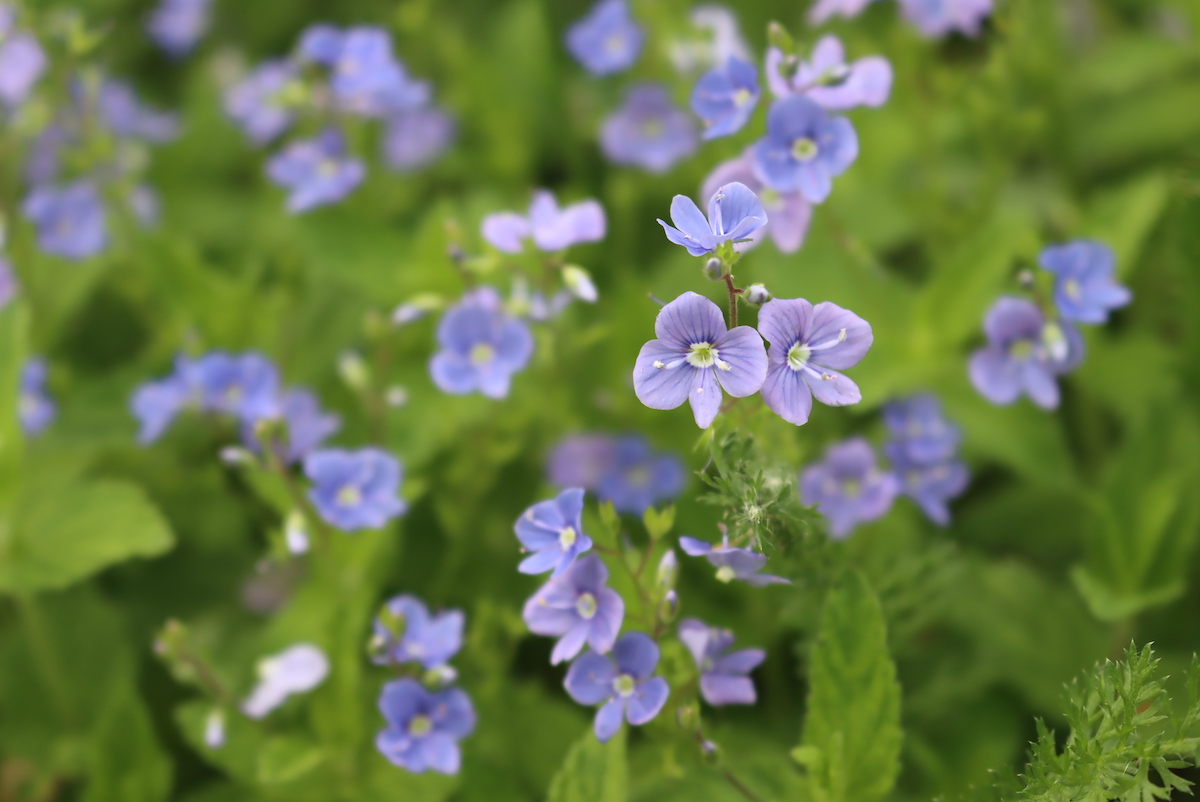
Cornflowers (Centaurea cyanus)
You can expect to find Cornflowers growing in cooler regions of the US. They have a tendency to droop in shade or when they get too tall, so keep an eye out in sunny spaces. During the summer months you can expect them to put out some of the most vibrantly blue flowers you’ll ever find. A native to Europe, Cornflowers are considered mildly invasive in many regions of the US.
The flowers are edible and prized for having a spicy, clove-like taste to them. You’ll want to keep your consumption low, however, as it is historically considered a diuretic. Other traditional uses include fever reduction, easing anxiety, and relieving menstrual cramps. But if you aren’t interested in eating them, Cornflowers hold up well after cutting and make excellent additions to vases or dried arrangements.
Key identification features
While Cornflowers and Chicory look similar, they are mostly confused by name—both have been given the common names of Cornflower and Bachelor’s Button! Physically you can tell them apart by looking at the shape of the petals: Cornflowers have furrowed inner petals while Chicory only grows flat petals.
Flowers:
- Single flowers on stem tips
- Forms a bract under the petals
- Bract is edged in black, toothed, and layered like shingles
- An outer layer of larger, flat petals
- An inner layer of smaller, furrowed petals
Leaves:
- Simple
- Smooth edged
- 1-4in long
- Covered in long, matted hairs
- Upper leaves along the stem are much narrower than those at the base
Here’s how to identify Cornflowers (Centaurea cyanus)
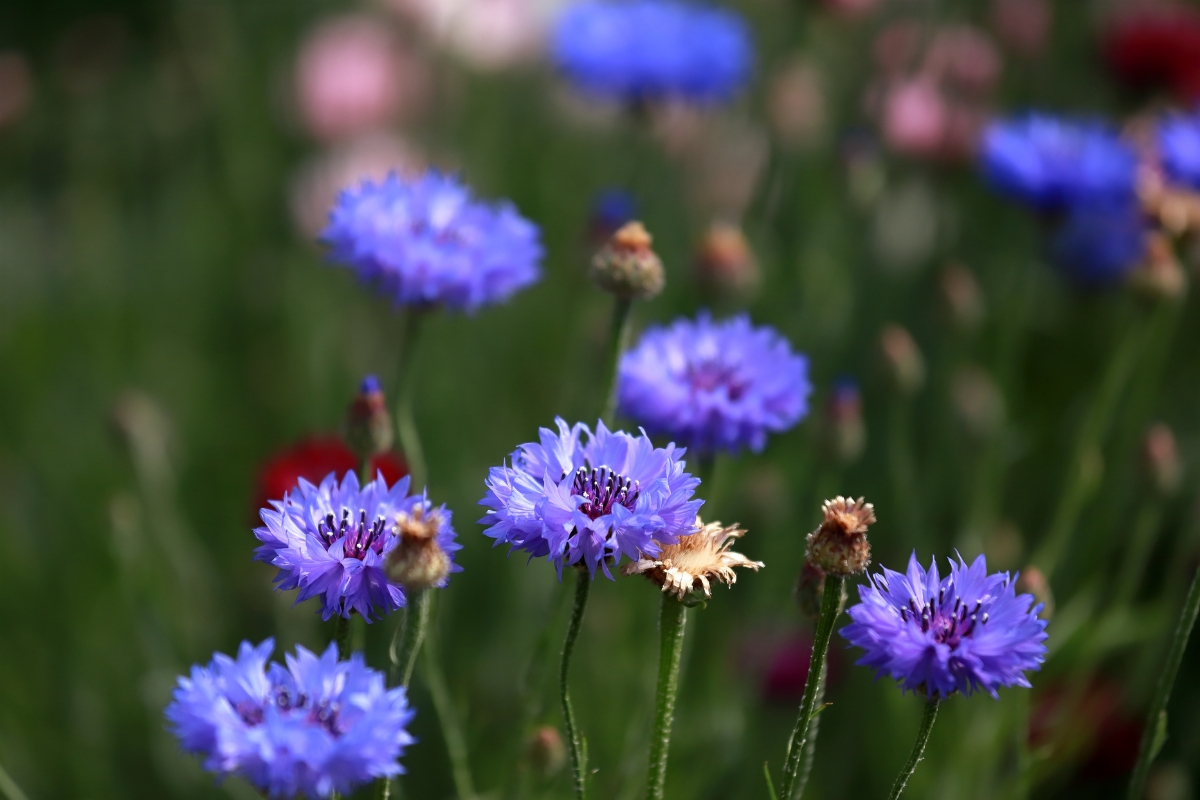
Creeping Bellflowers (Campanula rapunculoides)
Bellflower is a broad name for almost 500 species in the Campanula genus and most variants produce blue flowers. Originally grown in Europe, the genus has become wide-spread around the globe and can easily be found in the cooler regions of the US.
Prized for the beauty of their flowers and the way they attract hummingbirds, Bellflowers are a fun non-toxic addition to many gardens. The Creeping Bellflower specifically is both edible and considered highly invasive in the US. The tuberous rootstock is nutritious and has a taste similar to parsnips. Eating these roots is one of the best ways to control this species, so feel free to break out those trowels!
Key identification features
Creeping Bellflowers grow multiple, alternating flowers along a single stem, very similar to the way Penstemons flower. Penstemons differ in having fewer and narrower leaves. Additionally, their flowers have rounded points and an irregular shape compared to the pointed, even shape of Creeping Bellflowers.
Flowers:
- Upturned cup-shape
- 5-6 points along the edges
- Stand up above the leaves
Leaves:
- Multiple-shapes found on single plants
- Light green
- Upper leaves are narrower than basal leaves
General:
- Mounding plant
- Flowers grow on thin, wiry stems
Here’s how to identify Bellflowers (Campanula sp.)

False Forget-me-not (Hackelia floribunda)
It’s a strange thing to be best known for looking exactly like a completely different plant, particularly when that plant is not a native to your region, but that’s the situation False Forget-me-not finds itself in. A native plant to the US, it’s generally considered a weed because all parts of the plant are poisonous. Even getting scratched by the prickle of the seeds can cause swelling and irritation in the area.
Despite the whole plant being poisonous, Native Americans would use the roots to treat major injuries such as bone fractures. There haven’t been any studies done into how effective this might be today and it’s generally advised you avoid coming into contact with this plant.
Key identification features
As the False Forget-me-not, it’s no surprise you can confuse Hackelia Floribunda with true Forget-me-not. The main difference between the two is height: the False variety is erect and up to 3ft tall while the true variety grows low to the ground in a mat. See below for a deeper description of the true Forget-me-not.
Flowers:
- Funnel-shaped
- 5 lobes around the mouth of a central tube
- Tiny
- Pale blue
Seeds:
- Small
- Green
- Flattened nutlets
- A line of prickles along one edge
Leaves:
- Large
- Blue-green
- Hairy underneath
- Lance-shaped
General:
- Stems grow at a 45-degree angle
- Up to 3ft tall
Here’s how to identify False Forget-me-not (Hackelia floribunda)
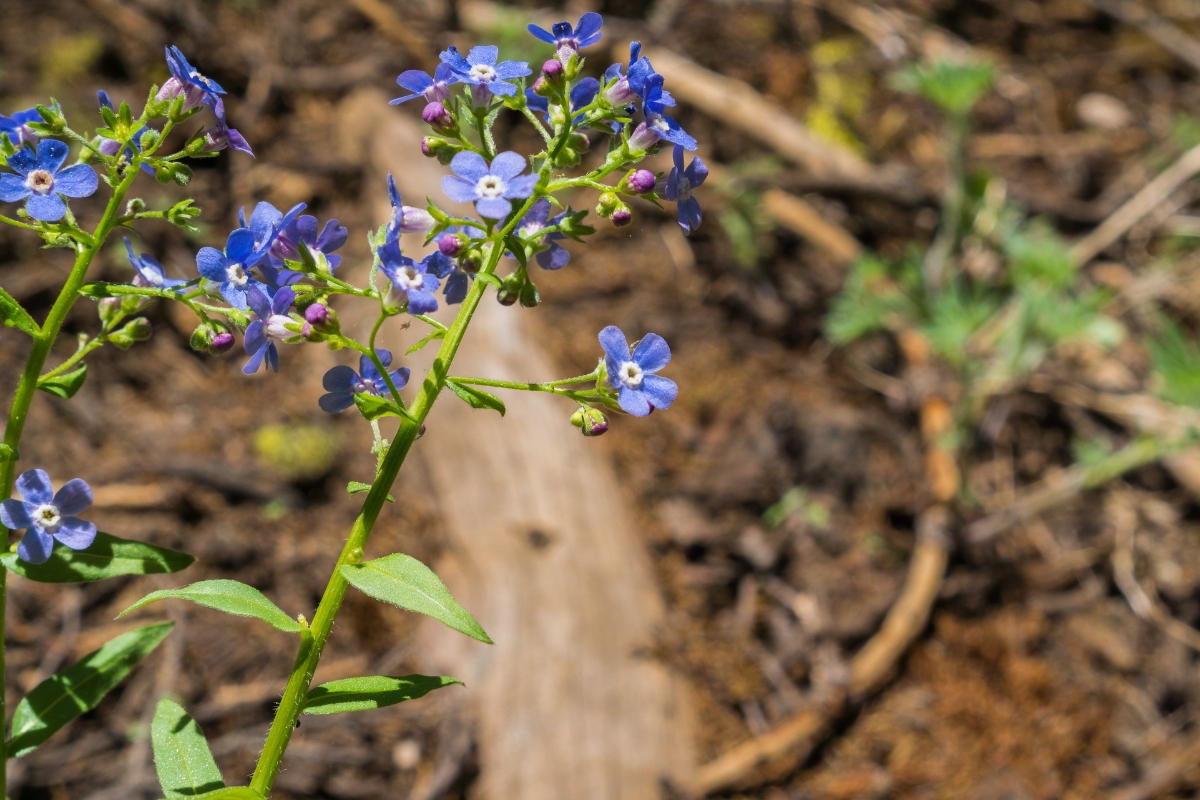
Flossflower (Ageratum houstonianum)
Flossflower is an excellent example of a weed that looks beautiful, has beneficial uses, and also has negative drawbacks. Native to South and Central America, this plant has become a notable invasive in the southeastern US. Additionally, this plant is toxic to grazing animals and should be removed from areas around livestock and other animals.
It’s an aggressive grower but looks beautiful to both people and pollinators when planted in gardens. Historically, leaves from the Flossflower have been pressed against wounds to help stop bleeding. More recent studies have shown the oils from this plant contain antimicrobial, antifungal, and pesticide properties. While it’s not edible, it has plenty of uses to go around!
Key identification features
Flossflower and Blue Mistflower look very similar (see above for a description of the differences)
Flowers:
- Feathery
- Grow in slightly rounded clusters
- 5-15 tubular florets
- Wilted flowers are replaced by new ones
Leaves:
- Oval to Heart-shaped
- 2in long
General:
- Low mounding plant
Here’s how to identify Flossflower (Ageratum houstonianum)

Forget-me-not (Myosotis scorpioides)
Our first aquatic plant! Forget-me-nots enjoy growing in ponds, swamps, or anywhere they have access to constant water. A favorite ornamental in home water features, it does escape into the wild and push out native plants if not kept in check. It has the word “scorpion” in its scientific name due to the way its flower stems begin coiled up and unfurl as the flowers bloom.
Historically it’s been used to treat bronchitis and whooping cough. It is considered mildly toxic and has been linked with liver damage when consumed regularly.
Key identification features
True Forget-me-not looks highly similar to the false variety (See above).
Flowers:
- Sky blue with yellow center
- 5 petals around the mouth of a central tube
Seeds:
- Smooth black
- Nutlets
Leaves:
- Hairy undersides
- Lance-shaped
- Prominent central vein
General:
- Stems are angled
- Stems are hairy
- Low growing
- Aquatic
- Buds form along tightly coiled stems
Here’s how to identify Forget-me-not (Myosotis scorpioides)
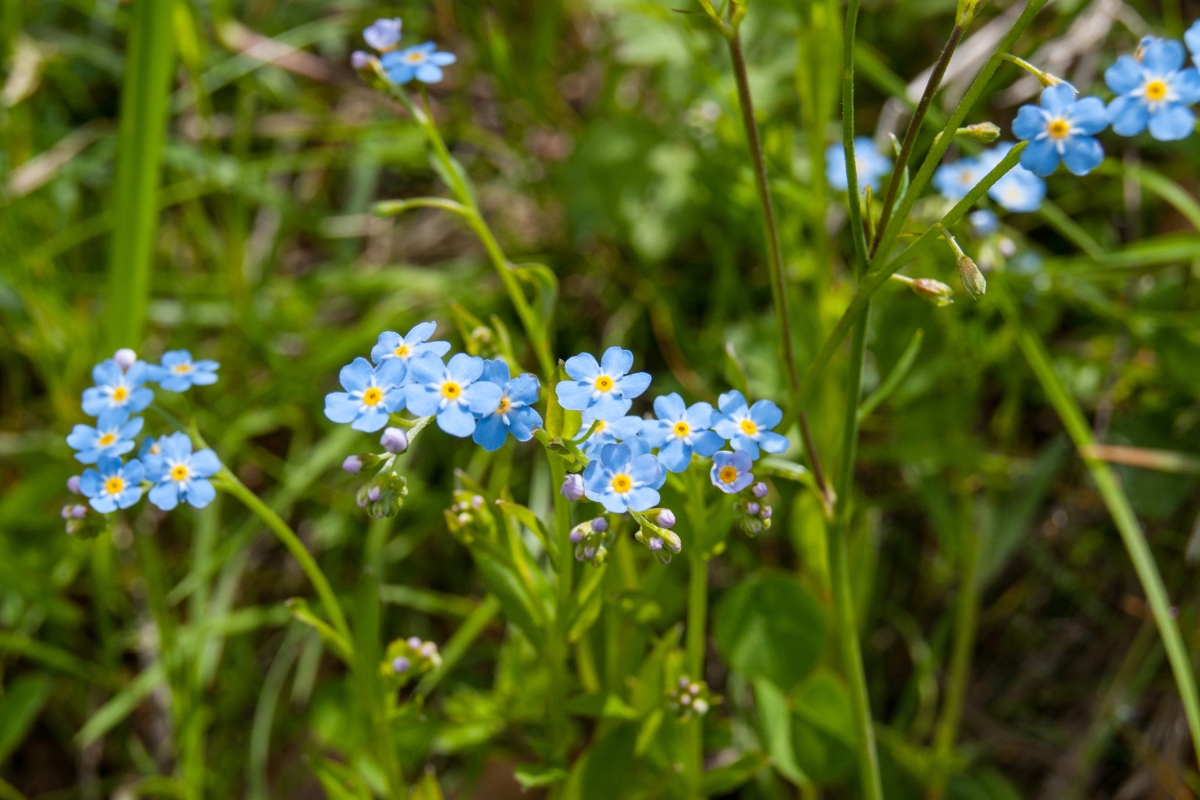
Grape Hyacinth (Muscari armeniacum)
You might smell this plant before you see it! The flowers let off a scent described anywhere from sweet to starchy to musky, which means you will likely need to have smelled it before to know when you’ve encountered it. It isn’t a native plant to the US and self-seeds itself well enough to be considered highly invasive.
If you have a strand of Grape Hyacinth growing wild locally or in your garden, you can eat the whole plant! The buds and blossoms are the most popular parts and are used to flavor foods. In the past, when having stiffly ironed clothes was in vogue, Grape Hyacinth was planted as a source of starch.
Key identification features
Flowers:
- Small
- Bell-shaped
- Tightly packed
Seeds:
- Tripartite seed pods
Leaves:
- Floppy
- Long
- Linear
General:
- Dies back in summer and winter
- Begins growing in spring and fall
- 1-3 stalks per bulb
Here’s how to identify Grape Hyacinth (Muscari sp.)
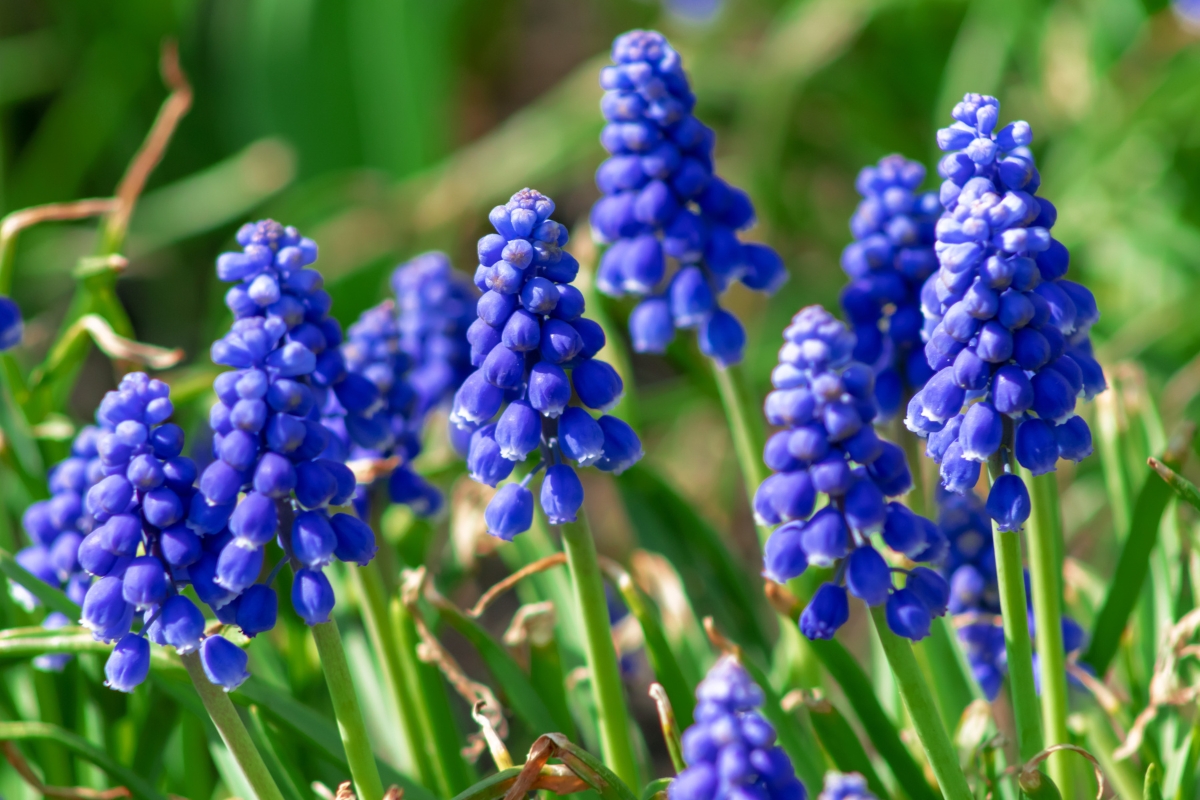
Green Alkanet (Pentaglottis sempervirens)
Another non-native plant that overstays its welcome, Green Alkanet is difficult to remove due to its deep, tenacious taproots. A highly adaptable plant, it has an incredibly wide range of climates it can be found growing in.
Despite this, it’s still a useful plant to have around: it’s a historical source for red dye (the name alkanet was derived long ago from Henna), can keep pollinators well fed, and may have properties to help in food preservation. The flowers are edible but the rest of the plant is generally not considered edible.
Key identification features
You may confuse Green Alkanet with several plants: Annual Bugloss, Anchusa, Blueweed, Comfrey, or even Forget-me-nots (both true and false). The easiest way to make sure you’re looking at Green Alkanet is to look at its leaves. All of the other plants have a variety of leaf shapes that look nothing like Alkanets—check for long-stemmed, broadly ovate, dark green leaves.
Flowers:
- 5 petals fused into a tube at the base
- Blue with a white center
- Grow in clusters at the ends of stems
Seeds:
- 4 nutlets per flower
Leaves:
- Grow on long stems
- Up to 15in including the stems
Ovate
- Become smaller as they go up the stem
General:
- Almost entirely covered in stiff hairs
Here’s how to identify Green Alkanet (Pentaglottis sempervirens)
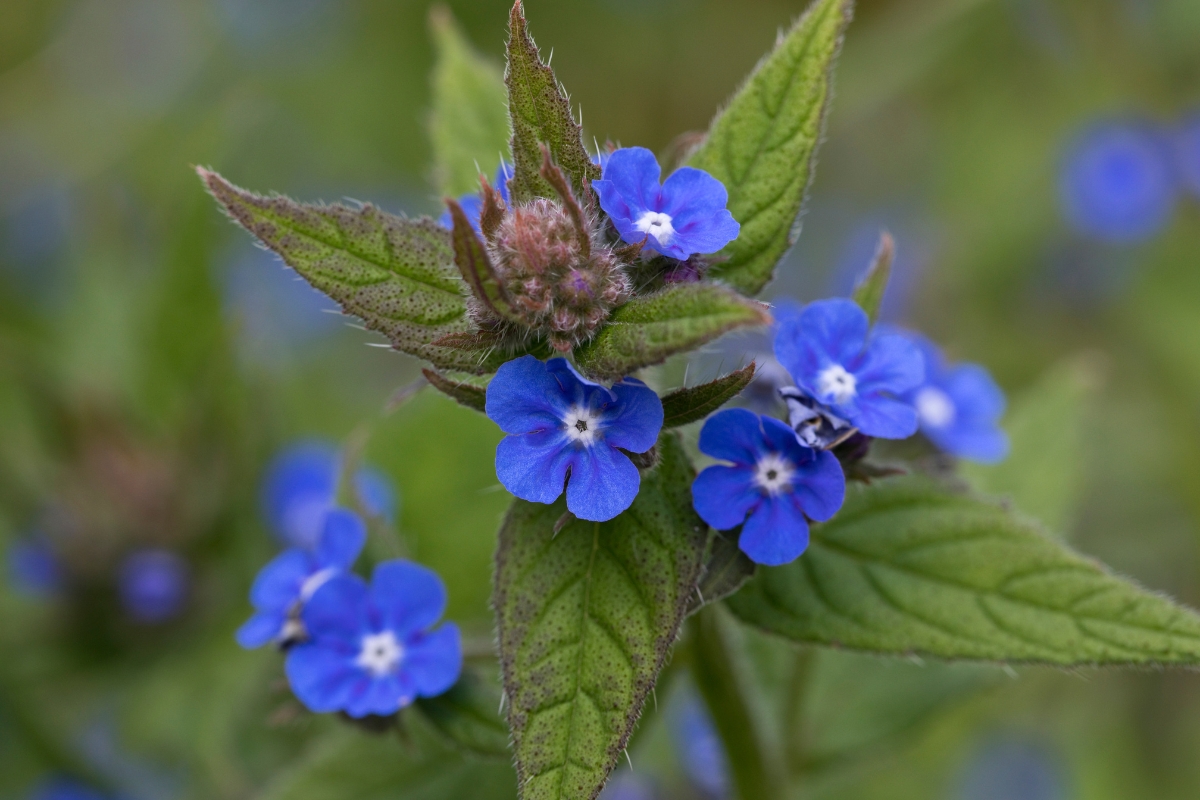
Hoary Aster (Dieteria canescens)
Hoary Aster (or Hoary Tansyaster) is such an aggressively growing plant, it’s main use is to try and outcompete non-native invasive species. Wildlife generally enjoys Hoary Asters as food, shelter, and as an attractor for insects.
The whole plant was routinely dried and powdered by Native Americans to treat nose and throat ailments. From there, Hoary Aster was put to a variety of uses as an emetic, an eyewash, a headache treatment, etc, and it’s unclear how effective it might be in any of these areas.
Key identification features
Flowers:
- Daisy-like
- Simple, smooth Petals
- Bright yellow, central disc florets
Leaves:
- Linear to oblong
- Up to 4in long at the base
- Serrated
General:
- Wooly haired stems
- Generally sticky and heavily scented
Here’s how to identify Hoary Aster (Dieteria canescens)

Larkspurs (Delphinium sp.)
If you’ve ever passed a plant with new flower buds out and thought, “Those look like little dolphins” then you’ve likely just passed a Larkspur! While not all 500 species of Larkspurs have this shape, enough of them do to justify the genus’ name reflecting this cute little detail.
The only known use for Larkspurs is as an attractor to bees, hummingbirds, and butterflies. Outside of this, the entire Larkspur plant is poisonous to both people and animals. Larkspurs are at their most poisonous when they’re young and become less so as they mature. However, at no stage in the growth cycle are Larkspurs considered safe to eat.
Key identification features
The Columbian Monkshood has a similar flower shape to many Larkspurs and the two can be confused (See Above).
Flowers:
- Spurred
- 5 sepals fused to form a pouch
- 4 petals are nestled inside the 5 sepals
Seeds:
- Small
- Shiny black
Leaves:
- 3-7 Deep lobes
- Lobes form a palmate shape
General:
- Hollow stem
- Erect flowering stem
Here’s how to identify Larkspurs (Delphinium sp.)
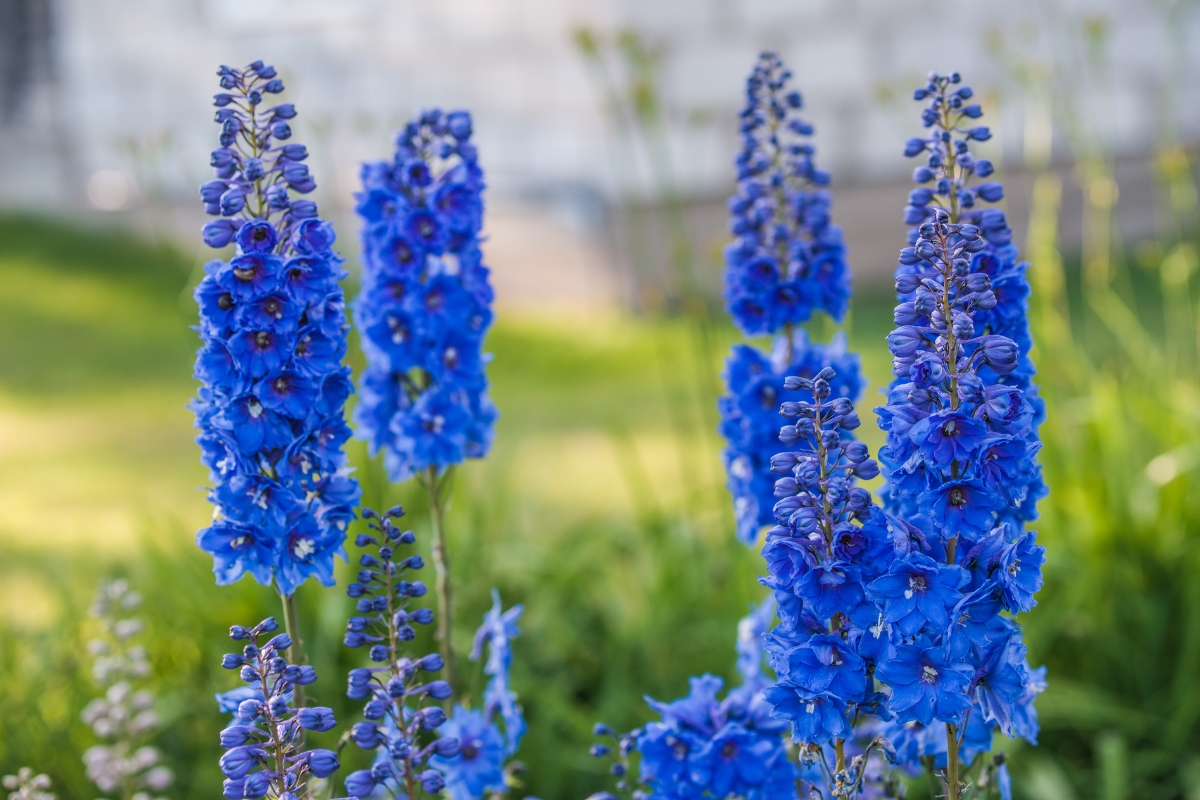
Lobelia (Lobelia sp.)
Another poisonous plant, Lobelia’s have many species in their genus but all are considered deadly. Not an aggressive plant, it’s easy to remove if it moves into your garden. If you’re establishing a pollinator garden, however, you may want to leave it as a plant with special value to native bees.
While you certainly shouldn’t eat it, the Lobelia does contain a compound that has proven effective in reducing nicotine addictions. Many gums and lozenges targeted at smokers contain this compound. Additionally, Lobelia was traditionally smoked by Native Americans as a treatment for bronchitis, asthma, coughs, and sore throats.
Key identification features
Flowers:
- Tubular
- Grow crowded together
- 2 main lips
- Upper lip has 2 segments
- Lower lip has 3 segments
Leaves:
- Ovate
Here’s how to identify Lobelia (Lobelia sp.)

Morning Glory (Ipomoea hederacea)
You’ll generally be able to recognize the local Morning Glories in your area by looking for fast growing vines up to 10ft in height with beautiful flowers that open each morning. There are hundreds of variants of Morning Glory and each one comes with its own leaf shape and flower color combo! While they are a fun addition to trellises, they’re tough to remove and generally considered invasive.
Both medicinal and toxic qualities are found in this genus. The blue varieties tend to have more medicinal properties than others. Generally, if you’re thinking about eating something made with Morning Glories, check with a local expert first to make sure you know which variety you’re working with.
Key identification features
Flowers:
- Trumpet-shaped
- 5 pointed star shape at center
- Clusters of up to 6 flowers
Seeds:
- Spherical Black-ish capsules
- Brittle pods break when they hit the ground
Foliage:
- Heart-shaped leaves
- 0-5 lobes
General:
- Stems tangled
- Climbing or running over the ground
- One leaf per lobe along the stem
Here’s how to identify Morning Glory (Ipomoea hederacea)
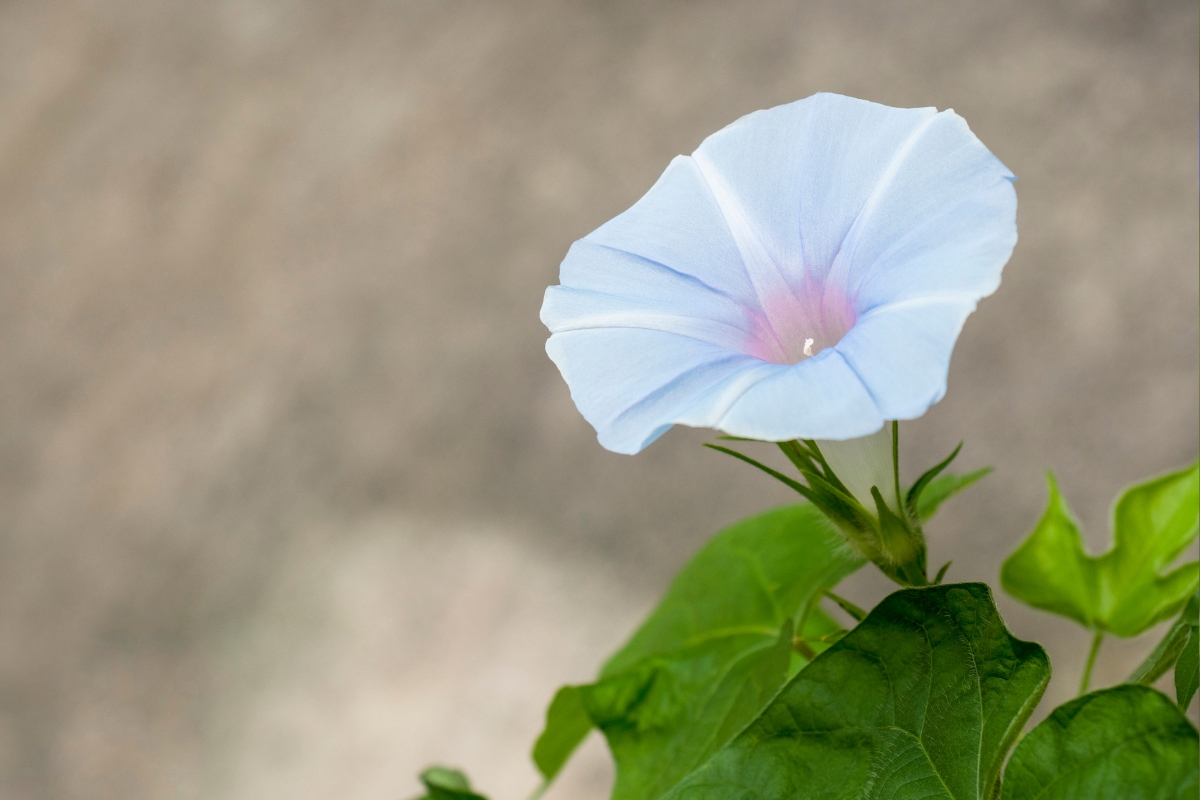
Passion Flower (Passiflora incarnata)
A viny plant that enjoys sunny areas, you’ll most easily recognize Passion Flowers by their large orange fruits. Growing up to the size of a hen’s egg when ripe, the round fruits are edible and delicious when ripe! Useful in flavoring drinks, making jams, included in desserts, the fruits are incredibly versatile. Even the flowers are beginning to be looked at as a sleep aid.
At the moment, Passion Flower isn’t considered invasive. It is a native to the US and is only considered a weed because of how quickly it spreads. There is some indication that it will become invasive in the future and is included as a weed here for this reason.
Key identification features
Flowers:
- Crimped inner sepals
- Simple outer petals
- Petals look like fine hair
Seeds:
- Large orange berries
- Black, .19in in size
Leaves:
- 3 lobed
- Dark green on top
- White underneath
General:
- Long, trailing stems
Here’s how to identify Passion Flower (Passiflora incarnata)
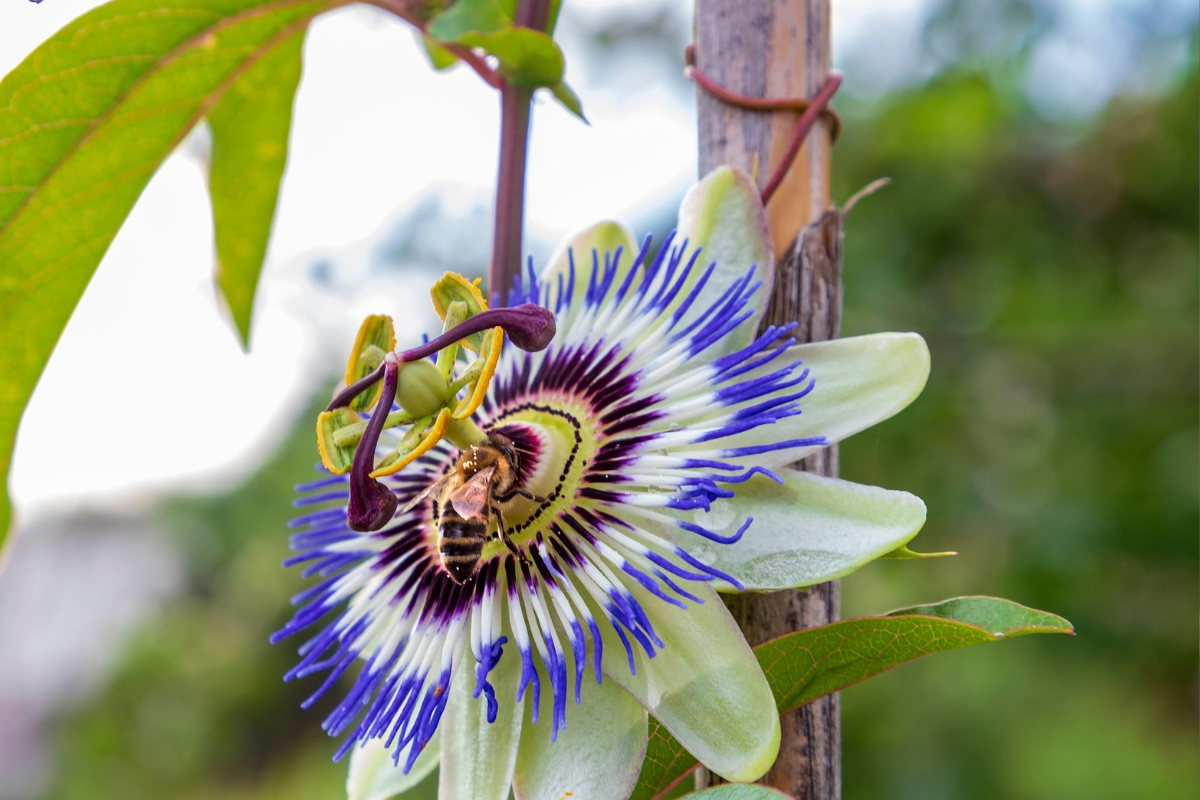
Lacy Phacelia (Phacelia tanacetifolia)
Drought tolerant to the extreme, Lacy Phacelia does not enjoy moisture and will only grow in gravelly soil. This is a bit of a shame as it is heavily relied upon as a cover crop for lower growing plants. Deep, wide roots help capture nutrients and increase the organic matter in the soil. It even acts as a pollinator attractor to help bring bees and butterflies into the path of less showy plants.
Lacy Phacelia is considered a native invasive in various regions of the US. It thrives in areas affected by wildfires and both acts as a soil stabilizer while potentially pushing out other plants from the area.
Key identification features
Flowers:
- Open on one side of the stem at a time
- 5 densely hairy sepals
- Bell-shaped with a fused corolla
Seeds:
- Ovoid fruit
- 2 seeds per fruit
- Brown
- Wrinkled
- Pitted
Leaves:
- Oblong
- Compound into many lobes
Here’s how to identify Lacy Phacelia (Phacelia tanacetifolia)
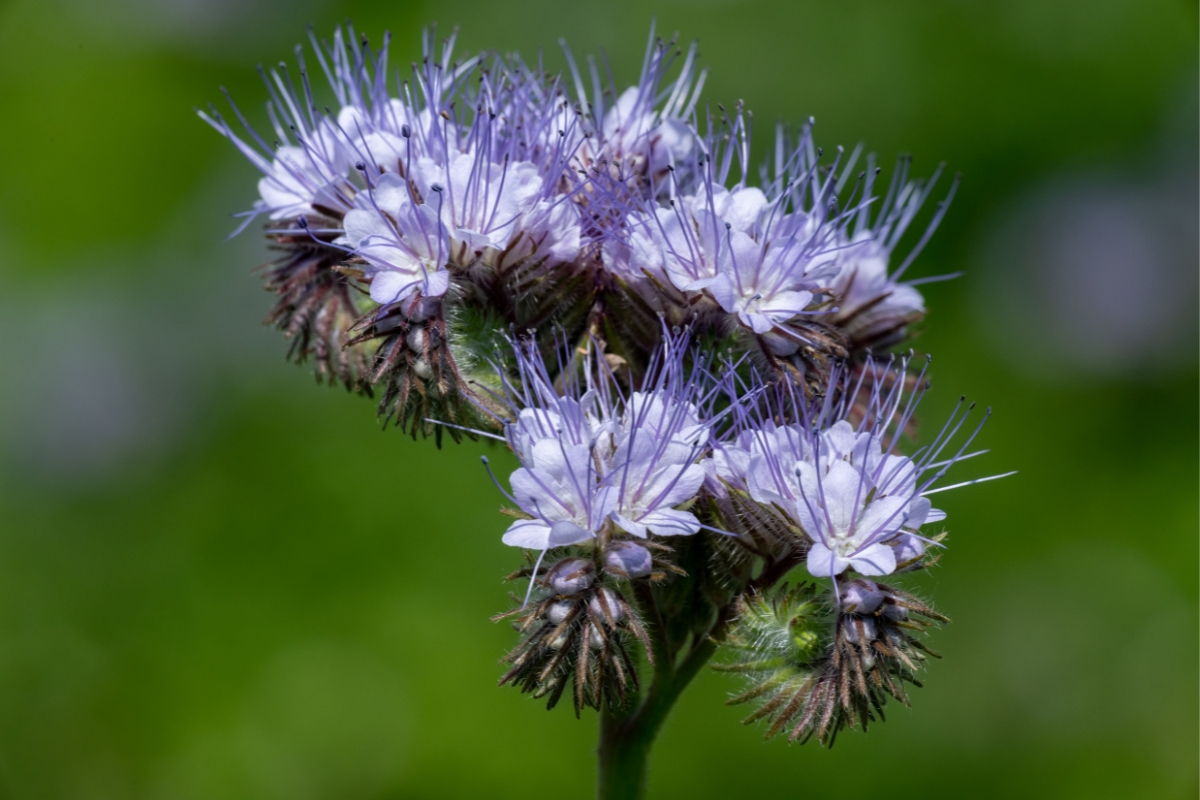
Venus’ Looking-glass (Triodanis perfoliata)
Generally considered weedy in its range for a habit of popping up in sidewalk cracks, Venus’ Looking-glass is a delicate native wildflower. With leaves and flowers all less than an inch across, the blue colored flowers are the only way this plant becomes noticeable.
While not edible, there’s a variety of ways this plant has been used medicinally over the years. The main one was to create an infusion to treat digestion issues, though even with this it’s unclear whether the infusion was used externally or internally. No matter its medicinal qualities, it does attract pollinators and is an excellent addition to any native garden.
Key identification features
Flowers:
- 5 petals
- Star-shaped
- Less than 1in across
Leaves:
- Green
- Hairy
- Less than 1in long
- Egg to Kidney shaped
- Upper leaves are hairless
General:
- Leaves and stems all have a milky sap
Here’s how to identify Venus’ Looking-glass (Triodanis perfoliata)
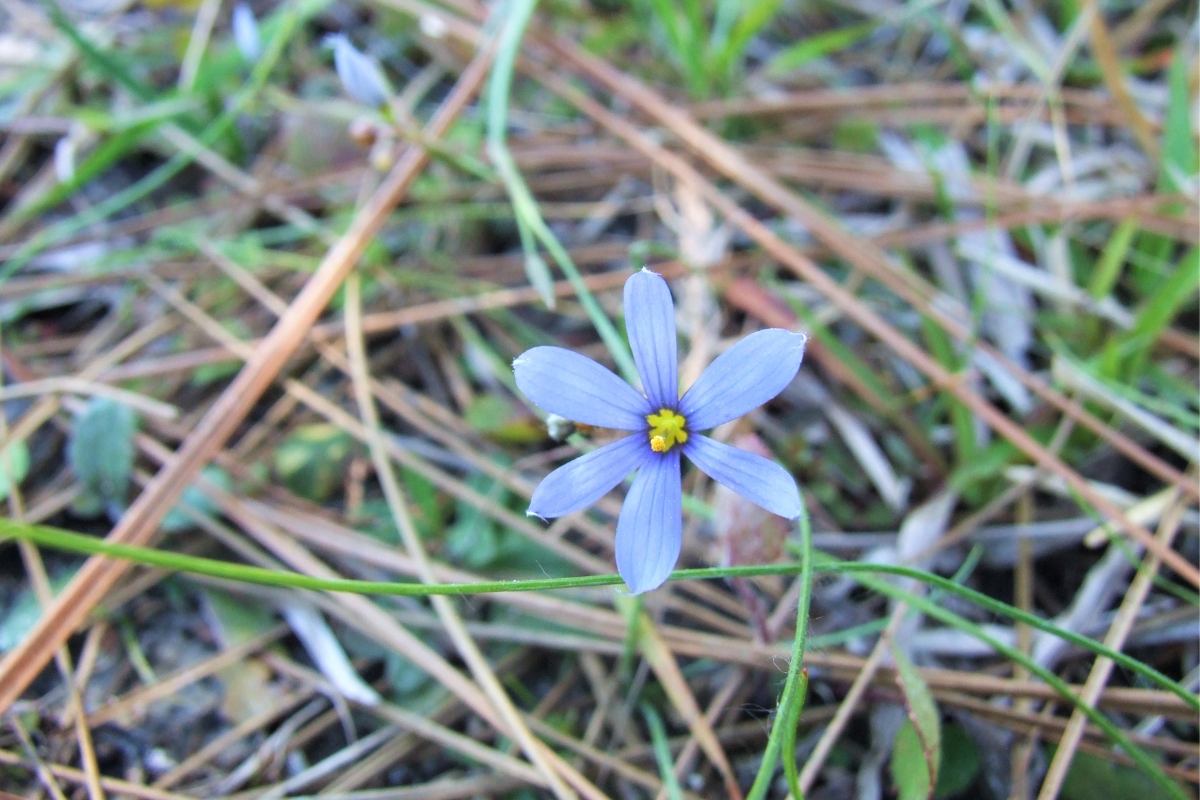
Viper’s Bugloss (Echium vulgare)
Taking its name from the speckling that many vipers have, Viper’s Bugloss was originally thought to help expel venom from snake bites. While this hasn’t proven true, it is true that this plant is almost as good for bees as clover. Additionally, the juice of the plant is soothing for most skins and can be used to treat carbuncles or boils. When chopped finely to avoid their hairiness, the leaves can be added to salads and contain a variety of medicinal properties.
A non-native to the US, Viper’s Bugloss is generally considered invasive. Feel free to dig it up and take it home!
Key identification features
Viper’s Bugloss is often confused for Houndstongue (Cynoglossum officinale) or Threadleaf Phacelia (Phacelia linearis). Fortunately, it’s easy to know if you’re looking at Viper’s Bugloss by looking for a spotted appearance on the stems from the swollen hairs.
Flowers:
- Funnel-shaped
- 5 lobed
- 4-5 long pink stamens
Seeds:
- Gray to brown nutlets
- Rounded pyramid shape
Leaves:
- Forms a basal rosette
- Lanceolate
- 2-10in in length
General:
- Covered in stout hairs on leaves and stems
- Hairs are swollen red, purple, or black bases
- Hair’s create a speckled or spotted appearance
Here’s how to identify Viper’s Bugloss (Echium vulgare)
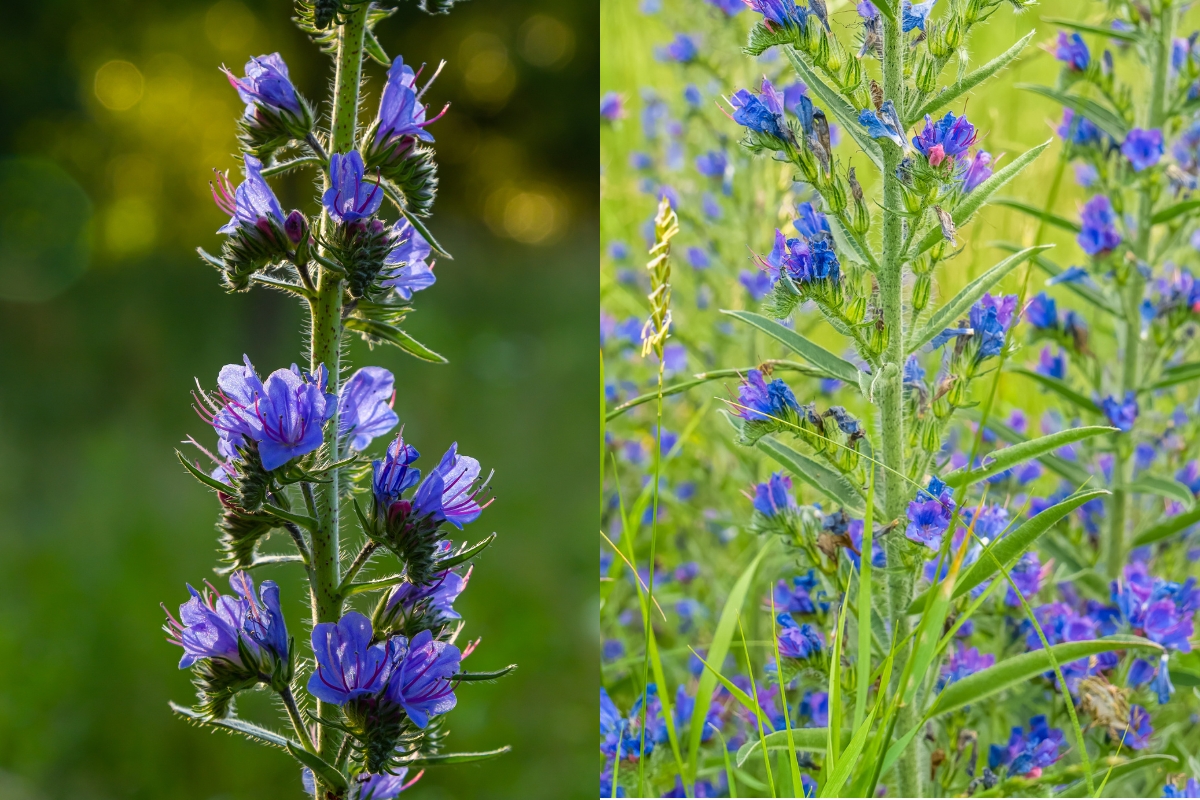
Virginia Spiderwort (Tradescantia virginiana)
Highly aggressive when it grows, Virginia Spiderwort is considered a native invasive. Preferring moist locations, you’ll find it happily spreading out in bogs, marshes, and other places where it can get plenty of water and sun.
Highly utilized by Native Americans, Virginia Spiderwort was eaten raw or fried, made into laxative teas, and the roots were mashed to make a poultice to treat cancers. When out on a walk, if you pass a Virginia Spiderwort you can mash the plant as an on-the-spot treatment for insect bites.
Key identification features
Spiderwort and Asiatic Dayflower have been said to have a similar flower shape but the plants themselves look different (See Above).
Flowers:
- 3 rounded petals
- Flowers die and are replaced each day
- Form clusters
Leaves:
- Green
- Linear
- Over 6in long
General:
- Clumping
Here’s how to identify Spiderwort (Tradescantia sp.)
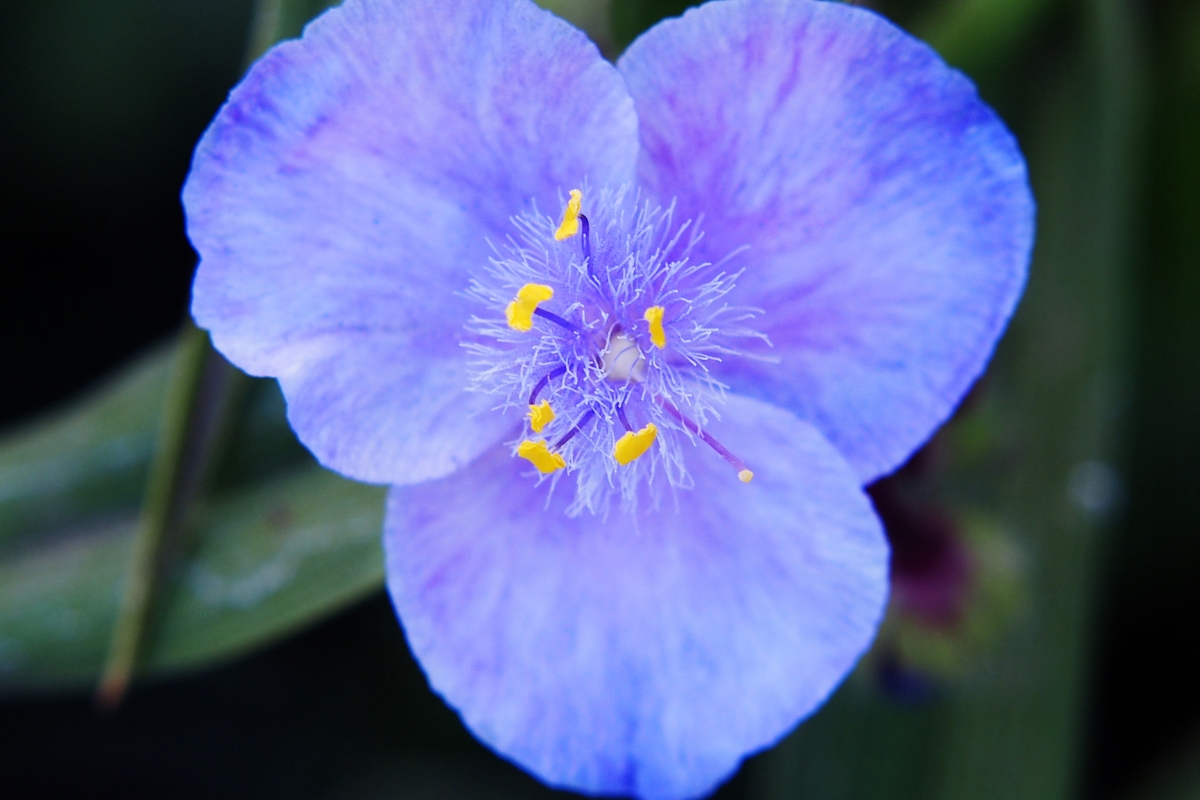
Virginia Waterleaf (Hydrophyllum sp.)
If you’re looking for a plant that can rapidly fill in bare areas of your garden, the Virginia Waterleaf is the plant for you! Be prepared though—with brittle stems and wide roots it can be difficult to get rid of once it’s settled.
Used in a variety of medicinal ways, the Virginia Waterleaf is mostly considered inedible. Roots were often eaten as an emetic, made into teas to treat diarrhea, or smeared on lips to treat cracking and sores. Today it’s mostly used to compete against non-native invasive plants and stabilize loose soil.
Key identification features
Flowers:
- Spherical cymes with 8-20 flowers
- Hairy green calyx
- Tubular with 5 lobes
- White, pink, or pale blue
Leaves:
- Broad
- Oval to triangular
- Divided into 3-7 lobes
General:
- Brittle stems
- Deep, wide roots
Here’s how to identify Virginia Waterleaf (Hydrophyllum sp.)
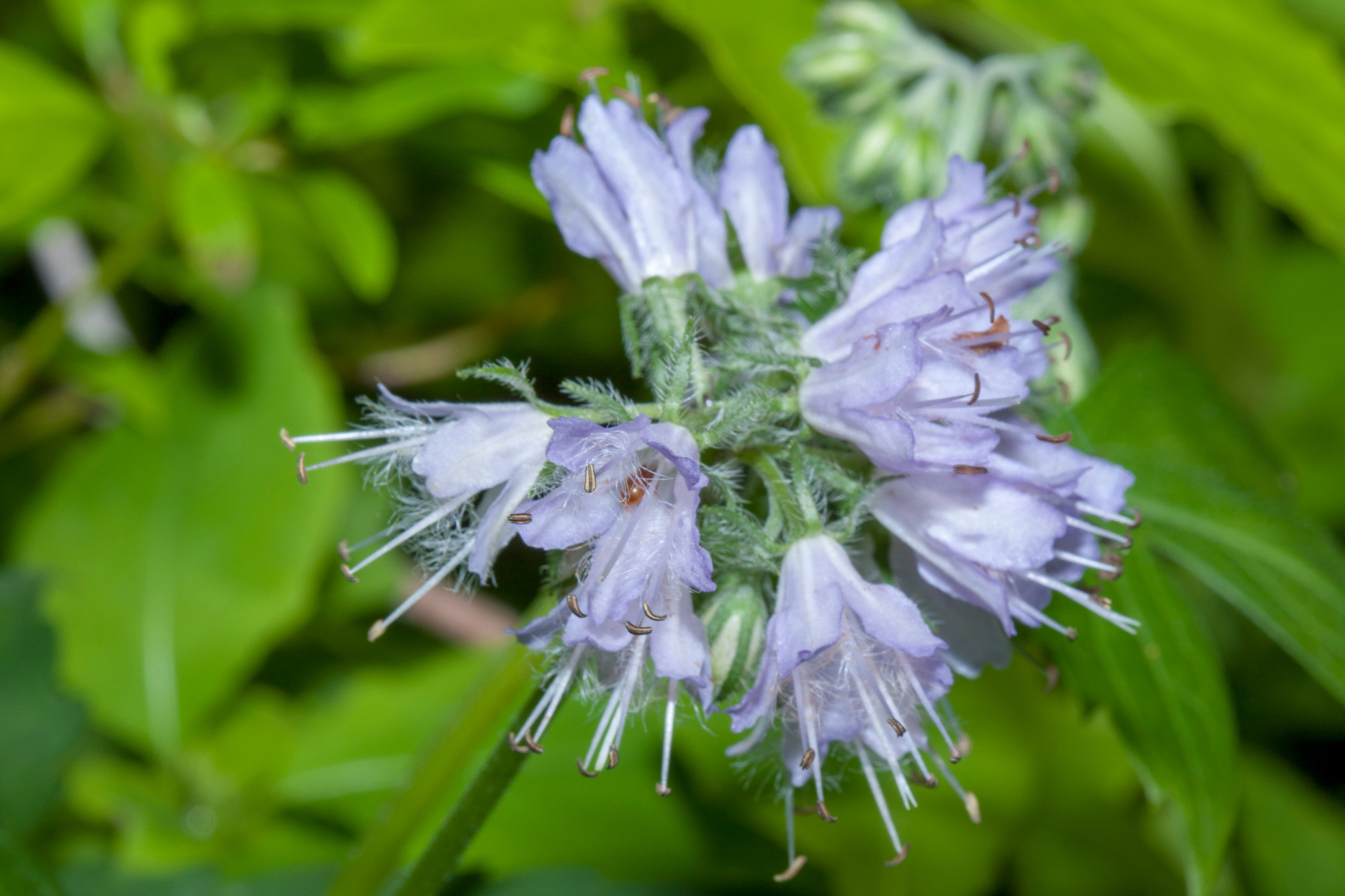
Wild Clary (Salvia verbenaca)
There are several species in the Salvia genus that are invasive in the US and produce blue flowers, but the most common of these is Wild Clary. As part of the salvia genus, it’s most easily recognizable by its scent as it is a variant of Sage.
Most useful in the kitchen, you can use the leaves and flowers to flavor food or make a tea to help with digestion. When soaked for a few minutes in water, you can use the leaves to make an eyewash suitable for removing dust from your eyes.
Key identification features
Flowers:
- 6-10 flowers per bract
- Lilac-like
Leaves:
- Ovate
- Irregularly toothed
- Smells like sage when bruised or rubbed
General:
- Hairy stems and leaves
Here’s how to identify Wild Clary (Salvia verbenaca)
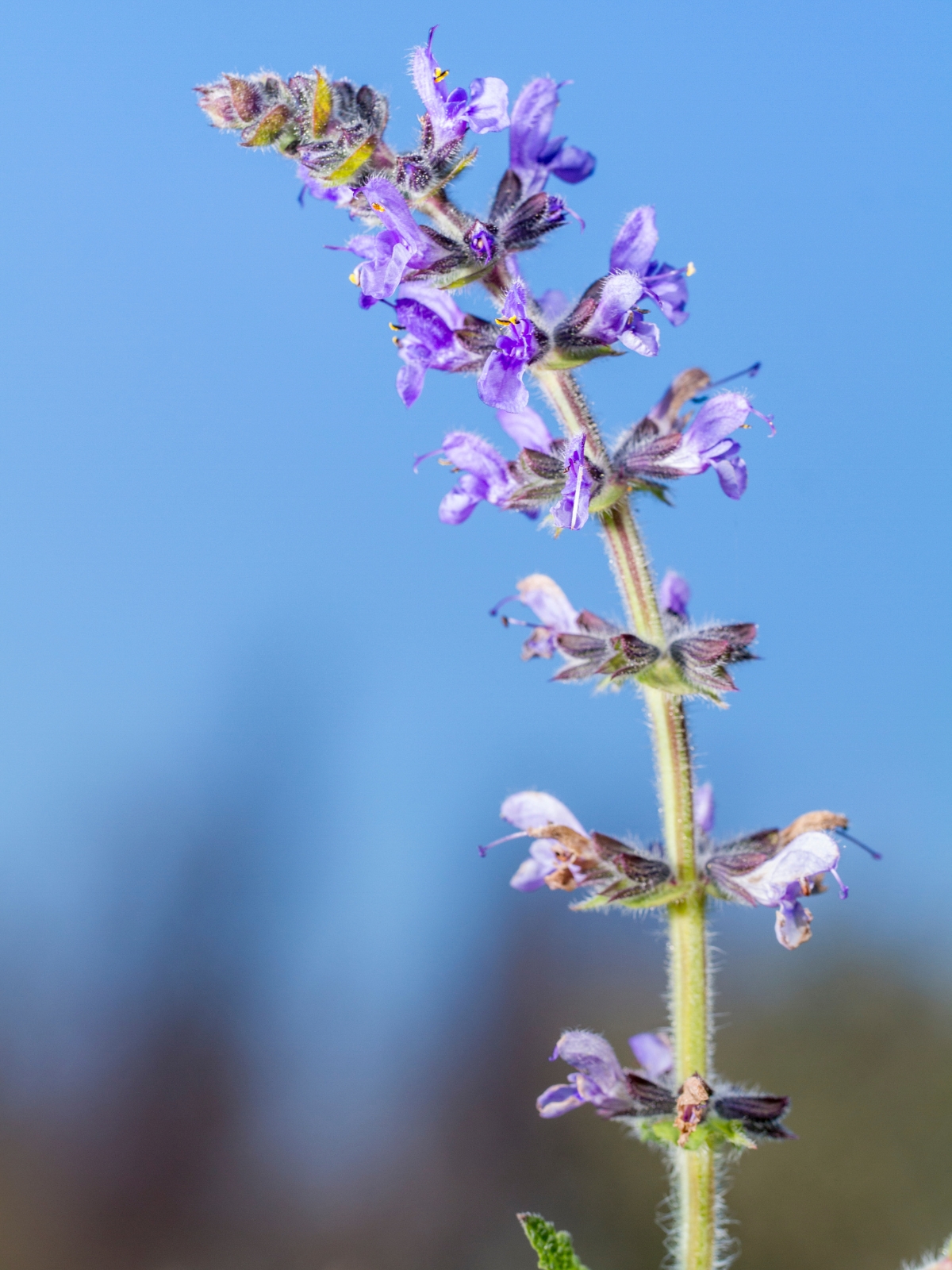
Woodland Lettuce (Lactuca floridana)
As the common name implies, Woodland Lettuce has edible leaves! Younger leaves can be added raw to salads, but older leaves should be cooked to make them more palatable. I found some reports of people using the milky sap from the stems to treat minor skin irritations including chapped lips but I couldn’t find any studies to explain how effective this might be.
Generally considered a common weed, Woodland Lettuce will happily grow wherever it can, including in vegetable gardens. Unlike many plants on this list, it isn’t an aggressive grower and is unlikely to push out the plants around it.
Key identification features
Flowers:
- Radial
- 7-20 petals
- .5in across
Leaves:
- Simple
- Lanceolate
- Deeply lobed
- 3-10in long
General:
- Purple stems
- Stems have a milky sap
Here’s how to identify Woodland Lettuce (Lactuca floridana)
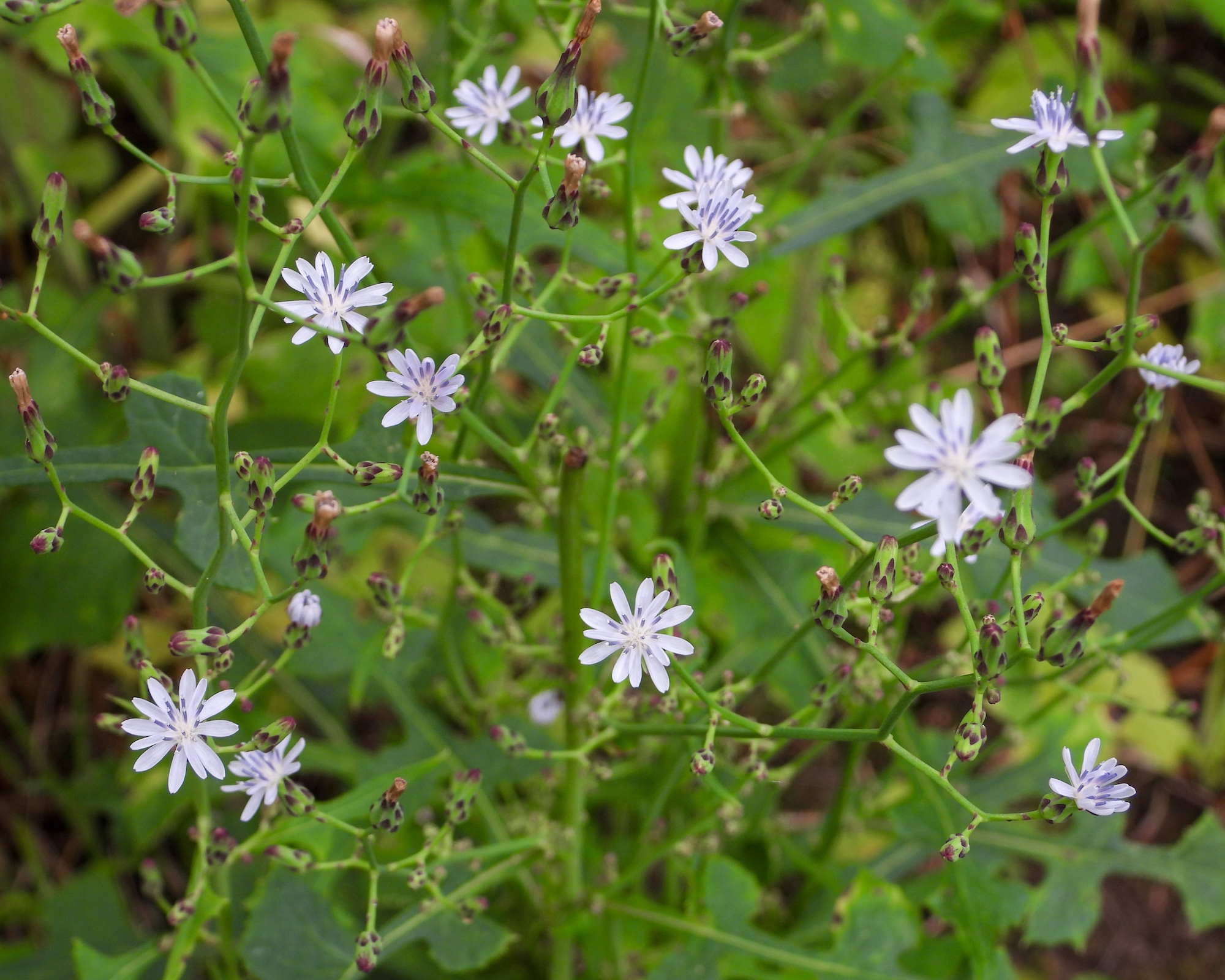
More plants with Blue flowers:
Do you have a wild plant in your yard with blue flowers and it wasn’t on this list? Check out some of the other native plants that grow in the US:
Wildflowers with Blue Flowers
- Blue Beardtongue (Penstemon sp.)
- Blue Curls (Trichostema dichotomum)
- Blue Hearts (Buchnera americana)
- Bluebells (Mertensia virginica)
- Bluet (Houstonia caerulea)
- California Harebell (Asyneuma prenanthoides)
- Colorado Blue Columbine (Aquilegia caerulea)
- Common Hepatica (Hepatica americana)
- Eastern Blue Star (Amsonia tabernaemontana)
- Gentians (Gentiana sp.)
- Irises (Iris sp.)
- Kittentails (Synthyris missurica)
- Large-leaved Aster (Eurybia macrophylla)
- Pasque Flower (Pulsatilla patens)
- Menzies’ Baby Blue Eyes (Nemophila menziesii)
- Monkeyflower (Mimulus alatus)
- Pickerelweed (Pontederia cordata)
- Prairie Pleat Leaf (Nemastylis geminiflora)
- Skullcap (Scutellaria sp.)
- Triplet-Lily (Triteleia grandiflora)
- Wild Blue Phlox (Phlox sp.)
- Wild Hyacinth (Camassia scilloides)
Rare to Endangered Blue Wildflower Species
- Blue-eyed Mary (Collinsia sp.)
- False Pennyroyal (Trichostema brachiatum)
- Jacob’s Ladder (Polemonium sp.)
- Wooly Stars (Eriastrum sp.)


